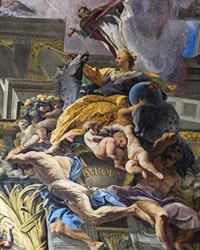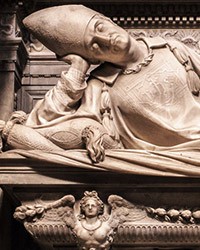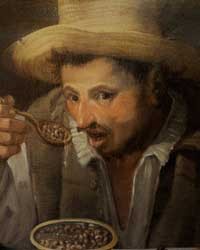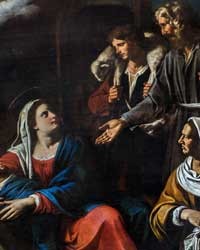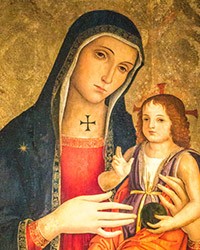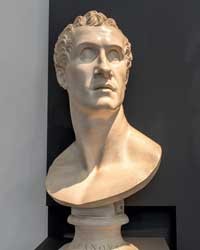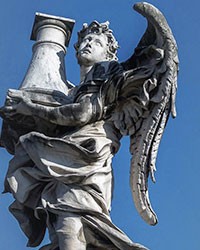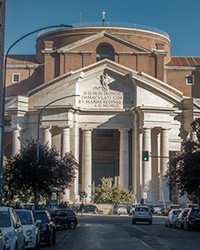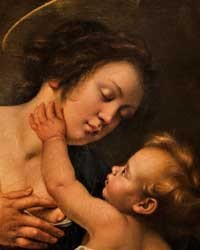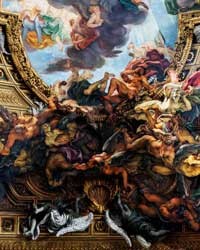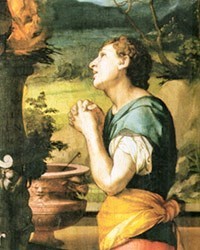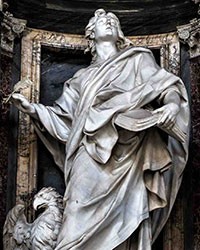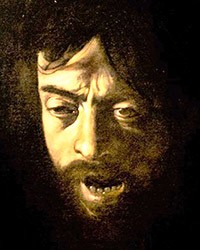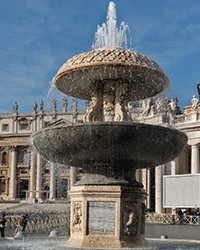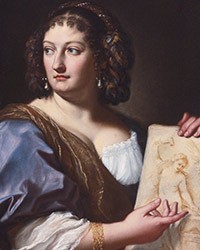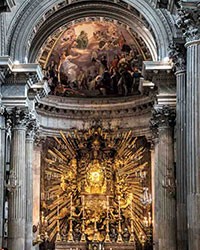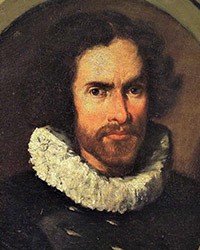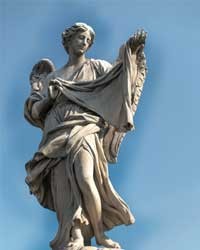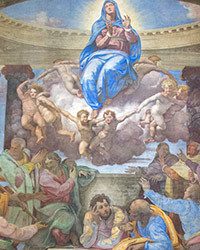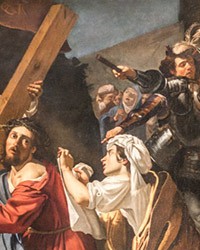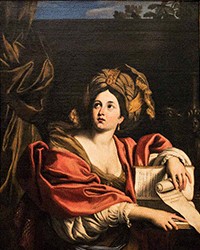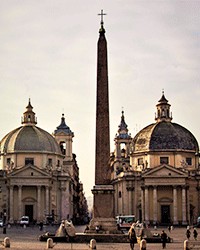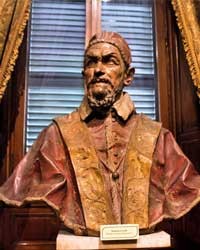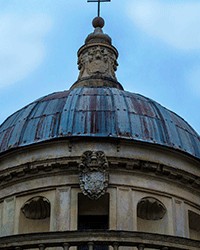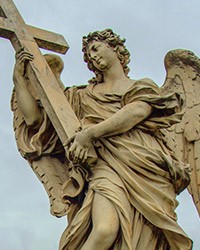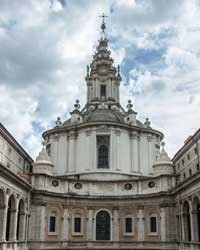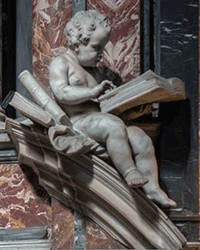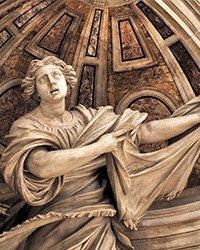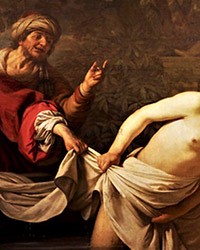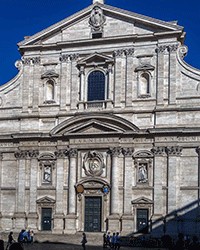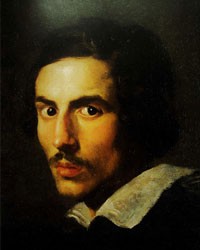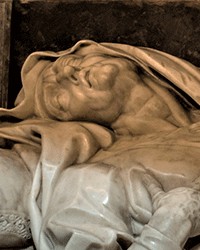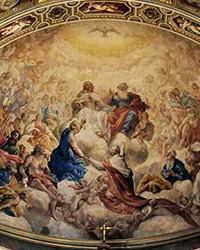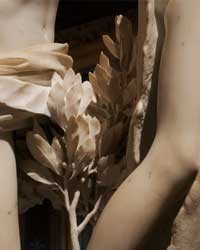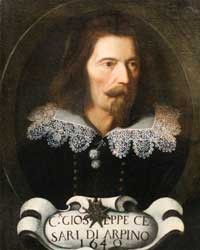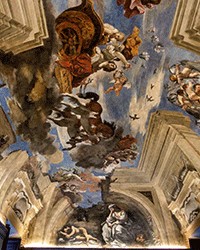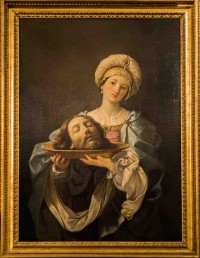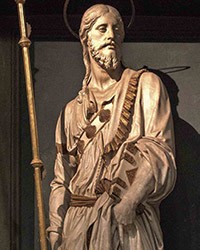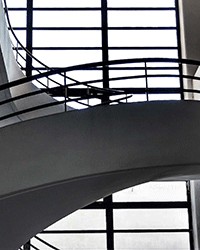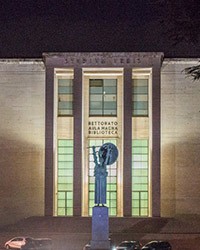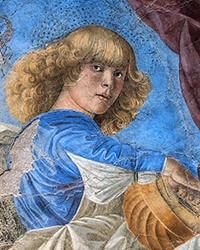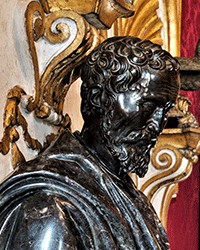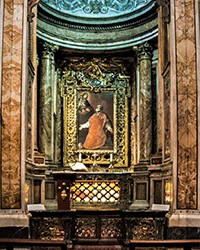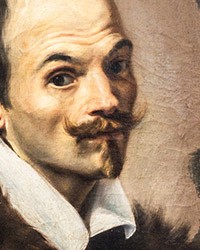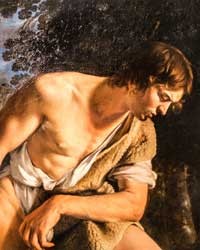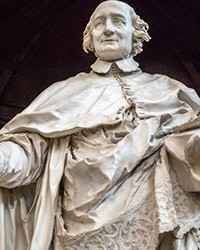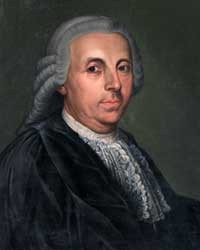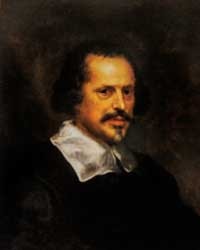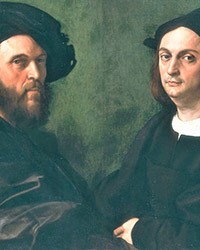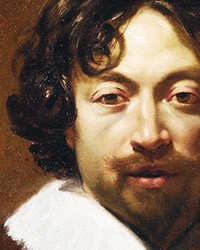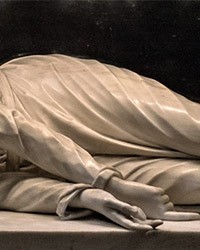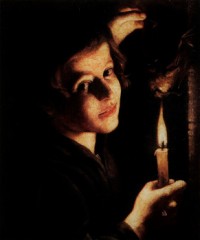
POSTACIE Artists
Artists
Andrea Sansovino (approx. 1467–1529) – the one who was able to bring the dead back to life
Antonio Canova (1757–1822) – praised by his contemporaries, disregarded by later generations
Artemisia Gentileschi (1593–1653) – an unwomanly painter, humiliated and forgotten for centuries
Bartolomeo Ammannati (1511–1592) – the beginnings of an outstanding career of a great Italian Mannerist
Carlo Maratti (Maratta) (1625–1713) – an outstanding portraitist and a father of an equally outstanding daughter
Dirck van Baburen (approx. 1592/93–1624) – a short, intense life of a Caravaggionist from the North
Giacomo della Porta (1533–1602), an author of Roman fountains and the most famous façade in the history of art
Giovanni (Gian) Lorenzo Bernini (1599–1680) – Impulsive, arrogant and ingenious favorite of the popes
Melozzo da Forlì (1438–1494) – the one who introduced the delicate touch of Renaissance to Rome
Orazio Borgianni (1574–1616) – a melancholic with intellectual ambitions and an explosive character
Pietro da Cortona (1596–1669) – a virtuoso of glories, triumphs and apotheoses of all kinds
Zgodnie z art. 13 ust. 1 i ust. 2 rozporządzenia Parlamentu Europejskiego i Rady (UE) 2016/679 z 27 kwietnia 2016 r. w sprawie ochrony osób fizycznych w związku z przetwarzaniem danych osobowych i w sprawie swobodnego przepływu takich danych oraz uchylenia dyrektywy 95/46/WE (RODO), informujemy, że Administratorem Pani/Pana danych osobowych jest firma: Econ-sk GmbH, Billbrookdeich 103, 22113 Hamburg, Niemcy
Przetwarzanie Pani/Pana danych osobowych będzie się odbywać na podstawie art. 6 RODO i w celu marketingowym Administrator powołuje się na prawnie uzasadniony interes, którym jest zbieranie danych statystycznych i analizowanie ruchu na stronie internetowej. Podanie danych osobowych na stronie internetowej http://roma-nonpertutti.com/ jest dobrowolne.
| Params | |
|---|---|
| 0 | |
| 1 | |
| 2 | |
| 3 | |
| 4 | |
| 5 | |
| 6 | |
| 7 | |
| 8 | |
| 9 | |
| Params | |
|---|---|
| 0 | |
| 1 | |
| 2 | |
| 3 | |
| 4 | |
| 5 | |
| 6 | |
| 7 | |
| 8 | |
| 9 | |
| 10 | |
| 11 | |
| 12 | |
| 13 | |
| 14 | |
| 15 | |
| 16 | |
| Params | |
|---|---|
| 0 | |
| 1 | |
| 2 | |
| 3 | |
| 4 | |
| 5 | |
| 6 | |
| 7 | |
| 8 | |
| 9 | |
| 10 | |
| 11 | |
| 12 | |
| 13 | |
| 14 | |
| 15 | |
| 16 | |
| Params | |
|---|---|
| 0 | |
| Params | |
|---|---|
| 0 | |
| 1 | |
| 2 | |
| 3 | |
| 4 | |
| 5 | |
| 6 | |
| 7 | |
| 8 | |
| 9 | |
| 10 | |
| 11 | |
| 12 | |
| 13 | |
| 14 | |
| 15 | |
| 16 | |
| Params | |
|---|---|
| 0 | |
| 1 | |
| 2 | |
| 3 | |
| 4 | |
| 5 | |
| 6 | |
| 7 | |
| 8 | |
| 9 | |
| 10 | |
| 11 | |
| 12 | |
| 13 | |
| 14 | |
| 15 | |
| 16 | |
| Params | |
|---|---|
| 0 | |
| 1 | |
| 2 | |
| 3 | |
| 4 | |
| 5 | |
| 6 | |
| 7 | |
| 8 | |
| 9 | |
| 10 | |
| 11 | |
| 12 | |
| 13 | |
| 14 | |
| 15 | |
| 16 | |
| Params | |
|---|---|
| 0 | |
| 1 | |
| 2 | |
| 3 | |
| 4 | |
| 5 | |
| 6 | |
| 7 | |
| 8 | |
| 9 | |
| 10 | |
| 11 | |
| 12 | |
| 13 | |
| 14 | |
| 15 | |
| 16 | |
| 17 | |
| 18 | |
| 19 | |
| 20 | |
| 21 | |
| 22 | |
select * from `articles_categories` where (`parent_id` is null and `status` = 'ACTIVE')4.42msbaza5943_roma| Metadata | |
|---|---|
| Bindings |
|
| Hints |
|
select * from `attributes` where (`table` = 'articles_categories')510μsbaza5943_roma| Metadata | |
|---|---|
| Bindings |
|
| Hints |
|
select * from `attributes_varchar` where `attribute_id` = '1' and `entity_id` = '1' and `lang` = 'en'470μsbaza5943_roma| Metadata | |
|---|---|
| Bindings |
|
| Hints |
|
select * from `articles_categories` where (`parent_id` = '1' and `status` = 'ACTIVE')450μsbaza5943_roma| Metadata | |
|---|---|
| Bindings |
|
| Hints |
|
select * from `attributes` where (`table` = 'articles_categories')390μsbaza5943_roma| Metadata | |
|---|---|
| Bindings |
|
| Hints |
|
select * from `attributes_varchar` where `attribute_id` = '1' and `entity_id` = '2' and `lang` = 'en'340μsbaza5943_roma| Metadata | |
|---|---|
| Bindings |
|
| Hints |
|
select * from `articles_categories` where (`parent_id` = '2' and `status` = 'ACTIVE')420μsbaza5943_roma| Metadata | |
|---|---|
| Bindings |
|
| Hints |
|
select * from `attributes` where (`table` = 'articles_categories')330μsbaza5943_roma| Metadata | |
|---|---|
| Bindings |
|
| Hints |
|
select * from `attributes_varchar` where `attribute_id` = '1' and `entity_id` = '3' and `lang` = 'en'680μsbaza5943_roma| Metadata | |
|---|---|
| Bindings |
|
| Hints |
|
select * from `articles_categories` where (`parent_id` = '3' and `status` = 'ACTIVE')330μsbaza5943_roma| Metadata | |
|---|---|
| Bindings |
|
| Hints |
|
select * from `attributes` where (`table` = 'articles_categories')360μsbaza5943_roma| Metadata | |
|---|---|
| Bindings |
|
| Hints |
|
select * from `attributes_varchar` where `attribute_id` = '1' and `entity_id` = '4' and `lang` = 'en'370μsbaza5943_roma| Metadata | |
|---|---|
| Bindings |
|
| Hints |
|
select * from `articles_categories` where (`parent_id` = '4' and `status` = 'ACTIVE')380μsbaza5943_roma| Metadata | |
|---|---|
| Bindings |
|
| Hints |
|
select * from `attributes` where (`table` = 'articles_categories')430μsbaza5943_roma| Metadata | |
|---|---|
| Bindings |
|
| Hints |
|
select * from `attributes_varchar` where `attribute_id` = '1' and `entity_id` = '5' and `lang` = 'en'430μsbaza5943_roma| Metadata | |
|---|---|
| Bindings |
|
| Hints |
|
select * from `articles_categories` where (`parent_id` = '5' and `status` = 'ACTIVE')340μsbaza5943_roma| Metadata | |
|---|---|
| Bindings |
|
| Hints |
|
select * from `attributes` where (`table` = 'articles_categories')400μsbaza5943_roma| Metadata | |
|---|---|
| Bindings |
|
| Hints |
|
select * from `attributes_varchar` where `attribute_id` = '1' and `entity_id` = '8' and `lang` = 'en'370μsbaza5943_roma| Metadata | |
|---|---|
| Bindings |
|
| Hints |
|
select * from `articles_categories` where (`parent_id` = '8' and `status` = 'ACTIVE')430μsbaza5943_roma| Metadata | |
|---|---|
| Bindings |
|
| Hints |
|
select * from `attributes` where (`table` = 'articles_categories')390μsbaza5943_roma| Metadata | |
|---|---|
| Bindings |
|
| Hints |
|
select * from `attributes_varchar` where `attribute_id` = '1' and `entity_id` = '9' and `lang` = 'en'370μsbaza5943_roma| Metadata | |
|---|---|
| Bindings |
|
| Hints |
|
select * from `articles_categories` where (`parent_id` = '9' and `status` = 'ACTIVE')310μsbaza5943_roma| Metadata | |
|---|---|
| Bindings |
|
| Hints |
|
select * from `attributes` where (`table` = 'articles_categories')450μsbaza5943_roma| Metadata | |
|---|---|
| Bindings |
|
| Hints |
|
select * from `attributes_varchar` where `attribute_id` = '1' and `entity_id` = '10' and `lang` = 'en'350μsbaza5943_roma| Metadata | |
|---|---|
| Bindings |
|
| Hints |
|
select * from `articles_categories` where (`parent_id` = '10' and `status` = 'ACTIVE')350μsbaza5943_roma| Metadata | |
|---|---|
| Bindings |
|
| Hints |
|
select * from `attributes` where (`table` = 'articles_categories')550μsbaza5943_roma| Metadata | |
|---|---|
| Bindings |
|
| Hints |
|
select * from `attributes_varchar` where `attribute_id` = '1' and `entity_id` = '11' and `lang` = 'en'280μsbaza5943_roma| Metadata | |
|---|---|
| Bindings |
|
| Hints |
|
select * from `articles_categories` where (`parent_id` = '11' and `status` = 'ACTIVE')330μsbaza5943_roma| Metadata | |
|---|---|
| Bindings |
|
| Hints |
|
select * from `attributes` where (`table` = 'articles_categories')450μsbaza5943_roma| Metadata | |
|---|---|
| Bindings |
|
| Hints |
|
select * from `attributes_varchar` where `attribute_id` = '1' and `entity_id` = '12' and `lang` = 'en'560μsbaza5943_roma| Metadata | |
|---|---|
| Bindings |
|
| Hints |
|
select * from `articles_categories` where (`parent_id` = '12' and `status` = 'ACTIVE')760μsbaza5943_roma| Metadata | |
|---|---|
| Bindings |
|
| Hints |
|
select * from `attributes` where (`table` = 'articles_categories')1.06msbaza5943_roma| Metadata | |
|---|---|
| Bindings |
|
| Hints |
|
select * from `attributes_varchar` where `attribute_id` = '1' and `entity_id` = '13' and `lang` = 'en'420μsbaza5943_roma| Metadata | |
|---|---|
| Bindings |
|
| Hints |
|
select * from `articles_categories` where (`parent_id` = '13' and `status` = 'ACTIVE')450μsbaza5943_roma| Metadata | |
|---|---|
| Bindings |
|
| Hints |
|
select * from `attributes` where (`table` = 'articles_categories')390μsbaza5943_roma| Metadata | |
|---|---|
| Bindings |
|
| Hints |
|
select * from `attributes_varchar` where `attribute_id` = '1' and `entity_id` = '14' and `lang` = 'en'620μsbaza5943_roma| Metadata | |
|---|---|
| Bindings |
|
| Hints |
|
select * from `articles_categories` where (`parent_id` = '14' and `status` = 'ACTIVE')410μsbaza5943_roma| Metadata | |
|---|---|
| Bindings |
|
| Hints |
|
select * from `attributes` where (`table` = 'articles_categories')380μsbaza5943_roma| Metadata | |
|---|---|
| Bindings |
|
| Hints |
|
select * from `attributes_varchar` where `attribute_id` = '1' and `entity_id` = '15' and `lang` = 'en'340μsbaza5943_roma| Metadata | |
|---|---|
| Bindings |
|
| Hints |
|
select * from `articles_categories` where (`parent_id` = '15' and `status` = 'ACTIVE')680μsbaza5943_roma| Metadata | |
|---|---|
| Bindings |
|
| Hints |
|
select * from `attributes` where (`table` = 'articles_categories')580μsbaza5943_roma| Metadata | |
|---|---|
| Bindings |
|
| Hints |
|
select * from `attributes_varchar` where `attribute_id` = '1' and `entity_id` = '16' and `lang` = 'en'320μsbaza5943_roma| Metadata | |
|---|---|
| Bindings |
|
| Hints |
|
select * from `articles_categories` where (`parent_id` = '16' and `status` = 'ACTIVE')470μsbaza5943_roma| Metadata | |
|---|---|
| Bindings |
|
| Hints |
|
select * from `attributes` where (`table` = 'articles_categories')310μsbaza5943_roma| Metadata | |
|---|---|
| Bindings |
|
| Hints |
|
select * from `attributes_varchar` where `attribute_id` = '1' and `entity_id` = '17' and `lang` = 'en'500μsbaza5943_roma| Metadata | |
|---|---|
| Bindings |
|
| Hints |
|
select * from `articles_categories` where (`parent_id` = '17' and `status` = 'ACTIVE')440μsbaza5943_roma| Metadata | |
|---|---|
| Bindings |
|
| Hints |
|
select * from `attributes` where (`table` = 'articles_categories')340μsbaza5943_roma| Metadata | |
|---|---|
| Bindings |
|
| Hints |
|
select * from `attributes_varchar` where `attribute_id` = '1' and `entity_id` = '18' and `lang` = 'en'370μsbaza5943_roma| Metadata | |
|---|---|
| Bindings |
|
| Hints |
|
select * from `articles_categories` where (`parent_id` = '18' and `status` = 'ACTIVE')320μsbaza5943_roma| Metadata | |
|---|---|
| Bindings |
|
| Hints |
|
select * from `attributes` where (`table` = 'articles_categories')280μsbaza5943_roma| Metadata | |
|---|---|
| Bindings |
|
| Hints |
|
select * from `attributes_varchar` where `attribute_id` = '1' and `entity_id` = '19' and `lang` = 'en'460μsbaza5943_roma| Metadata | |
|---|---|
| Bindings |
|
| Hints |
|
select * from `articles_categories` where (`parent_id` = '19' and `status` = 'ACTIVE')390μsbaza5943_roma| Metadata | |
|---|---|
| Bindings |
|
| Hints |
|
select * from `attributes` where (`table` = 'articles_categories')350μsbaza5943_roma| Metadata | |
|---|---|
| Bindings |
|
| Hints |
|
select * from `attributes_varchar` where `attribute_id` = '1' and `entity_id` = '20' and `lang` = 'en'390μsbaza5943_roma| Metadata | |
|---|---|
| Bindings |
|
| Hints |
|
select * from `articles_categories` where (`parent_id` = '20' and `status` = 'ACTIVE')540μsbaza5943_roma| Metadata | |
|---|---|
| Bindings |
|
| Hints |
|
select * from `attributes` where (`table` = 'articles_categories')520μsbaza5943_roma| Metadata | |
|---|---|
| Bindings |
|
| Hints |
|
select * from `attributes_varchar` where `attribute_id` = '1' and `entity_id` = '21' and `lang` = 'en'400μsbaza5943_roma| Metadata | |
|---|---|
| Bindings |
|
| Hints |
|
select * from `articles_categories` where (`parent_id` = '21' and `status` = 'ACTIVE')580μsbaza5943_roma| Metadata | |
|---|---|
| Bindings |
|
| Hints |
|
select * from `attributes` where (`table` = 'articles_categories')310μsbaza5943_roma| Metadata | |
|---|---|
| Bindings |
|
| Hints |
|
select * from `attributes_varchar` where `attribute_id` = '1' and `entity_id` = '22' and `lang` = 'en'390μsbaza5943_roma| Metadata | |
|---|---|
| Bindings |
|
| Hints |
|
select * from `articles_categories` where (`parent_id` = '22' and `status` = 'ACTIVE')380μsbaza5943_roma| Metadata | |
|---|---|
| Bindings |
|
| Hints |
|
select * from `attributes` where (`table` = 'articles_categories')410μsbaza5943_roma| Metadata | |
|---|---|
| Bindings |
|
| Hints |
|
select * from `attributes_varchar` where `attribute_id` = '1' and `entity_id` = '23' and `lang` = 'en'310μsbaza5943_roma| Metadata | |
|---|---|
| Bindings |
|
| Hints |
|
select * from `articles_categories` where (`parent_id` = '23' and `status` = 'ACTIVE')440μsbaza5943_roma| Metadata | |
|---|---|
| Bindings |
|
| Hints |
|
select * from `attributes` where (`table` = 'articles_categories')740μsbaza5943_roma| Metadata | |
|---|---|
| Bindings |
|
| Hints |
|
select * from `attributes_varchar` where `attribute_id` = '1' and `entity_id` = '24' and `lang` = 'en'310μsbaza5943_roma| Metadata | |
|---|---|
| Bindings |
|
| Hints |
|
select * from `articles_categories` where (`parent_id` = '24' and `status` = 'ACTIVE')280μsbaza5943_roma| Metadata | |
|---|---|
| Bindings |
|
| Hints |
|
select * from `attributes` where (`table` = 'articles_categories')300μsbaza5943_roma| Metadata | |
|---|---|
| Bindings |
|
| Hints |
|
select * from `attributes_varchar` where `attribute_id` = '1' and `entity_id` = '25' and `lang` = 'en'330μsbaza5943_roma| Metadata | |
|---|---|
| Bindings |
|
| Hints |
|
select * from `articles_categories` where (`parent_id` = '25' and `status` = 'ACTIVE')390μsbaza5943_roma| Metadata | |
|---|---|
| Bindings |
|
| Hints |
|
select * from `attributes` where (`table` = 'articles_categories')340μsbaza5943_roma| Metadata | |
|---|---|
| Bindings |
|
| Hints |
|
select * from `attributes_varchar` where `attribute_id` = '1' and `entity_id` = '26' and `lang` = 'en'520μsbaza5943_roma| Metadata | |
|---|---|
| Bindings |
|
| Hints |
|
select * from `articles_categories` where (`parent_id` = '26' and `status` = 'ACTIVE')250μsbaza5943_roma| Metadata | |
|---|---|
| Bindings |
|
| Hints |
|
select * from `attributes` where (`table` = 'articles_categories')290μsbaza5943_roma| Metadata | |
|---|---|
| Bindings |
|
| Hints |
|
select * from `attributes_varchar` where `attribute_id` = '1' and `entity_id` = '27' and `lang` = 'en'380μsbaza5943_roma| Metadata | |
|---|---|
| Bindings |
|
| Hints |
|
select * from `articles_categories` where (`parent_id` = '27' and `status` = 'ACTIVE')670μsbaza5943_roma| Metadata | |
|---|---|
| Bindings |
|
| Hints |
|
select * from `attributes` where (`table` = 'articles_categories')330μsbaza5943_roma| Metadata | |
|---|---|
| Bindings |
|
| Hints |
|
select * from `attributes_varchar` where `attribute_id` = '1' and `entity_id` = '28' and `lang` = 'en'520μsbaza5943_roma| Metadata | |
|---|---|
| Bindings |
|
| Hints |
|
select * from `articles_categories` where (`parent_id` = '28' and `status` = 'ACTIVE')400μsbaza5943_roma| Metadata | |
|---|---|
| Bindings |
|
| Hints |
|
select * from `attributes` where (`table` = 'articles_categories')360μsbaza5943_roma| Metadata | |
|---|---|
| Bindings |
|
| Hints |
|
select * from `attributes_varchar` where `attribute_id` = '1' and `entity_id` = '29' and `lang` = 'en'320μsbaza5943_roma| Metadata | |
|---|---|
| Bindings |
|
| Hints |
|
select * from `articles_categories` where (`parent_id` = '29' and `status` = 'ACTIVE')410μsbaza5943_roma| Metadata | |
|---|---|
| Bindings |
|
| Hints |
|
select * from `settings`350μsbaza5943_roma| Metadata | |
|---|---|
| Hints |
|
select * from `articles_categories` where `articles_categories`.`id` = '2' limit 1430μsbaza5943_roma| Metadata | |
|---|---|
| Bindings |
|
| Hints |
|
select * from `articles` where exists (select * from `articles_categories` inner join `articles_categories_join` on `articles_categories`.`id` = `articles_categories_join`.`category_id` where `articles`.`id` = `articles_categories_join`.`article_id` and `status` = 'ACTIVE') and `articles`.`deleted_at` is null order by `created_at` desc limit 3600μsbaza5943_roma| Metadata | |
|---|---|
| Bindings |
|
| Hints |
|
select * from `attributes` where (`table` = 'articles')620μsbaza5943_roma| Metadata | |
|---|---|
| Bindings |
|
| Hints |
|
select * from `attributes_varchar` where `attribute_id` = '2' and `entity_id` = '559' and `lang` = 'en'510μsbaza5943_roma| Metadata | |
|---|---|
| Bindings |
|
| Hints |
|
select * from `attributes_text` where `attribute_id` = '3' and `entity_id` = '559' and `lang` = 'en'670μsbaza5943_roma| Metadata | |
|---|---|
| Bindings |
|
| Hints |
|
select * from `attributes_text` where `attribute_id` = '6' and `entity_id` = '559' and `lang` = 'en'680μsbaza5943_roma| Metadata | |
|---|---|
| Bindings |
|
| Hints |
|
select * from `urls` where `table` = 'articles' and `entity_id` = '559'570μsbaza5943_roma| Metadata | |
|---|---|
| Bindings |
|
| Hints |
|
select * from `articles_photos` where `article_id` = '559'370μsbaza5943_roma| Metadata | |
|---|---|
| Bindings |
|
| Hints |
|
select * from `attributes` where (`table` = 'articles_photos')540μsbaza5943_roma| Metadata | |
|---|---|
| Bindings |
|
| Hints |
|
select * from `attributes_varchar` where `attribute_id` = '5' and `entity_id` = '8010' and `lang` = 'en'450μsbaza5943_roma| Metadata | |
|---|---|
| Bindings |
|
| Hints |
|
select * from `attributes` where (`table` = 'articles_photos')360μsbaza5943_roma| Metadata | |
|---|---|
| Bindings |
|
| Hints |
|
select * from `attributes_varchar` where `attribute_id` = '5' and `entity_id` = '8011' and `lang` = 'en'420μsbaza5943_roma| Metadata | |
|---|---|
| Bindings |
|
| Hints |
|
select * from `attributes` where (`table` = 'articles_photos')500μsbaza5943_roma| Metadata | |
|---|---|
| Bindings |
|
| Hints |
|
select * from `attributes_varchar` where `attribute_id` = '5' and `entity_id` = '8012' and `lang` = 'en'540μsbaza5943_roma| Metadata | |
|---|---|
| Bindings |
|
| Hints |
|
select * from `attributes` where (`table` = 'articles_photos')360μsbaza5943_roma| Metadata | |
|---|---|
| Bindings |
|
| Hints |
|
select * from `attributes_varchar` where `attribute_id` = '5' and `entity_id` = '8013' and `lang` = 'en'450μsbaza5943_roma| Metadata | |
|---|---|
| Bindings |
|
| Hints |
|
select * from `attributes` where (`table` = 'articles_photos')490μsbaza5943_roma| Metadata | |
|---|---|
| Bindings |
|
| Hints |
|
select * from `attributes_varchar` where `attribute_id` = '5' and `entity_id` = '8014' and `lang` = 'en'310μsbaza5943_roma| Metadata | |
|---|---|
| Bindings |
|
| Hints |
|
select * from `attributes` where (`table` = 'articles_photos')450μsbaza5943_roma| Metadata | |
|---|---|
| Bindings |
|
| Hints |
|
select * from `attributes_varchar` where `attribute_id` = '5' and `entity_id` = '8015' and `lang` = 'en'410μsbaza5943_roma| Metadata | |
|---|---|
| Bindings |
|
| Hints |
|
select * from `articles_photos` where `article_id` = '559' and `main_photo` = '1'360μsbaza5943_roma| Metadata | |
|---|---|
| Bindings |
|
| Hints |
|
select * from `attributes` where (`table` = 'articles_photos')580μsbaza5943_roma| Metadata | |
|---|---|
| Bindings |
|
| Hints |
|
select * from `attributes_varchar` where `attribute_id` = '5' and `entity_id` = '8010' and `lang` = 'en'390μsbaza5943_roma| Metadata | |
|---|---|
| Bindings |
|
| Hints |
|
select * from `attributes` where (`table` = 'articles')410μsbaza5943_roma| Metadata | |
|---|---|
| Bindings |
|
| Hints |
|
select * from `attributes_varchar` where `attribute_id` = '2' and `entity_id` = '558' and `lang` = 'en'480μsbaza5943_roma| Metadata | |
|---|---|
| Bindings |
|
| Hints |
|
select * from `attributes_text` where `attribute_id` = '3' and `entity_id` = '558' and `lang` = 'en'460μsbaza5943_roma| Metadata | |
|---|---|
| Bindings |
|
| Hints |
|
select * from `attributes_text` where `attribute_id` = '6' and `entity_id` = '558' and `lang` = 'en'430μsbaza5943_roma| Metadata | |
|---|---|
| Bindings |
|
| Hints |
|
select * from `urls` where `table` = 'articles' and `entity_id` = '558'640μsbaza5943_roma| Metadata | |
|---|---|
| Bindings |
|
| Hints |
|
select * from `articles_photos` where `article_id` = '558'630μsbaza5943_roma| Metadata | |
|---|---|
| Bindings |
|
| Hints |
|
select * from `attributes` where (`table` = 'articles_photos')590μsbaza5943_roma| Metadata | |
|---|---|
| Bindings |
|
| Hints |
|
select * from `attributes_varchar` where `attribute_id` = '5' and `entity_id` = '7991' and `lang` = 'en'350μsbaza5943_roma| Metadata | |
|---|---|
| Bindings |
|
| Hints |
|
select * from `attributes` where (`table` = 'articles_photos')360μsbaza5943_roma| Metadata | |
|---|---|
| Bindings |
|
| Hints |
|
select * from `attributes_varchar` where `attribute_id` = '5' and `entity_id` = '7992' and `lang` = 'en'400μsbaza5943_roma| Metadata | |
|---|---|
| Bindings |
|
| Hints |
|
select * from `attributes` where (`table` = 'articles_photos')340μsbaza5943_roma| Metadata | |
|---|---|
| Bindings |
|
| Hints |
|
select * from `attributes_varchar` where `attribute_id` = '5' and `entity_id` = '7993' and `lang` = 'en'380μsbaza5943_roma| Metadata | |
|---|---|
| Bindings |
|
| Hints |
|
select * from `attributes` where (`table` = 'articles_photos')290μsbaza5943_roma| Metadata | |
|---|---|
| Bindings |
|
| Hints |
|
select * from `attributes_varchar` where `attribute_id` = '5' and `entity_id` = '7994' and `lang` = 'en'410μsbaza5943_roma| Metadata | |
|---|---|
| Bindings |
|
| Hints |
|
select * from `attributes` where (`table` = 'articles_photos')410μsbaza5943_roma| Metadata | |
|---|---|
| Bindings |
|
| Hints |
|
select * from `attributes_varchar` where `attribute_id` = '5' and `entity_id` = '7995' and `lang` = 'en'560μsbaza5943_roma| Metadata | |
|---|---|
| Bindings |
|
| Hints |
|
select * from `attributes` where (`table` = 'articles_photos')510μsbaza5943_roma| Metadata | |
|---|---|
| Bindings |
|
| Hints |
|
select * from `attributes_varchar` where `attribute_id` = '5' and `entity_id` = '7996' and `lang` = 'en'510μsbaza5943_roma| Metadata | |
|---|---|
| Bindings |
|
| Hints |
|
select * from `attributes` where (`table` = 'articles_photos')330μsbaza5943_roma| Metadata | |
|---|---|
| Bindings |
|
| Hints |
|
select * from `attributes_varchar` where `attribute_id` = '5' and `entity_id` = '7998' and `lang` = 'en'480μsbaza5943_roma| Metadata | |
|---|---|
| Bindings |
|
| Hints |
|
select * from `attributes` where (`table` = 'articles_photos')320μsbaza5943_roma| Metadata | |
|---|---|
| Bindings |
|
| Hints |
|
select * from `attributes_varchar` where `attribute_id` = '5' and `entity_id` = '7999' and `lang` = 'en'470μsbaza5943_roma| Metadata | |
|---|---|
| Bindings |
|
| Hints |
|
select * from `attributes` where (`table` = 'articles_photos')340μsbaza5943_roma| Metadata | |
|---|---|
| Bindings |
|
| Hints |
|
select * from `attributes_varchar` where `attribute_id` = '5' and `entity_id` = '8000' and `lang` = 'en'410μsbaza5943_roma| Metadata | |
|---|---|
| Bindings |
|
| Hints |
|
select * from `attributes` where (`table` = 'articles_photos')340μsbaza5943_roma| Metadata | |
|---|---|
| Bindings |
|
| Hints |
|
select * from `attributes_varchar` where `attribute_id` = '5' and `entity_id` = '8001' and `lang` = 'en'640μsbaza5943_roma| Metadata | |
|---|---|
| Bindings |
|
| Hints |
|
select * from `attributes` where (`table` = 'articles_photos')320μsbaza5943_roma| Metadata | |
|---|---|
| Bindings |
|
| Hints |
|
select * from `attributes_varchar` where `attribute_id` = '5' and `entity_id` = '8002' and `lang` = 'en'420μsbaza5943_roma| Metadata | |
|---|---|
| Bindings |
|
| Hints |
|
select * from `attributes` where (`table` = 'articles_photos')390μsbaza5943_roma| Metadata | |
|---|---|
| Bindings |
|
| Hints |
|
select * from `attributes_varchar` where `attribute_id` = '5' and `entity_id` = '8003' and `lang` = 'en'350μsbaza5943_roma| Metadata | |
|---|---|
| Bindings |
|
| Hints |
|
select * from `attributes` where (`table` = 'articles_photos')370μsbaza5943_roma| Metadata | |
|---|---|
| Bindings |
|
| Hints |
|
select * from `attributes_varchar` where `attribute_id` = '5' and `entity_id` = '8004' and `lang` = 'en'560μsbaza5943_roma| Metadata | |
|---|---|
| Bindings |
|
| Hints |
|
select * from `attributes` where (`table` = 'articles_photos')540μsbaza5943_roma| Metadata | |
|---|---|
| Bindings |
|
| Hints |
|
select * from `attributes_varchar` where `attribute_id` = '5' and `entity_id` = '8005' and `lang` = 'en'400μsbaza5943_roma| Metadata | |
|---|---|
| Bindings |
|
| Hints |
|
select * from `attributes` where (`table` = 'articles_photos')280μsbaza5943_roma| Metadata | |
|---|---|
| Bindings |
|
| Hints |
|
select * from `attributes_varchar` where `attribute_id` = '5' and `entity_id` = '8006' and `lang` = 'en'360μsbaza5943_roma| Metadata | |
|---|---|
| Bindings |
|
| Hints |
|
select * from `attributes` where (`table` = 'articles_photos')330μsbaza5943_roma| Metadata | |
|---|---|
| Bindings |
|
| Hints |
|
select * from `attributes_varchar` where `attribute_id` = '5' and `entity_id` = '8007' and `lang` = 'en'570μsbaza5943_roma| Metadata | |
|---|---|
| Bindings |
|
| Hints |
|
select * from `attributes` where (`table` = 'articles_photos')530μsbaza5943_roma| Metadata | |
|---|---|
| Bindings |
|
| Hints |
|
select * from `attributes_varchar` where `attribute_id` = '5' and `entity_id` = '8008' and `lang` = 'en'410μsbaza5943_roma| Metadata | |
|---|---|
| Bindings |
|
| Hints |
|
select * from `attributes` where (`table` = 'articles_photos')320μsbaza5943_roma| Metadata | |
|---|---|
| Bindings |
|
| Hints |
|
select * from `attributes_varchar` where `attribute_id` = '5' and `entity_id` = '8009' and `lang` = 'en'390μsbaza5943_roma| Metadata | |
|---|---|
| Bindings |
|
| Hints |
|
select * from `articles_photos` where `article_id` = '558' and `main_photo` = '1'400μsbaza5943_roma| Metadata | |
|---|---|
| Bindings |
|
| Hints |
|
select * from `attributes` where (`table` = 'articles_photos')340μsbaza5943_roma| Metadata | |
|---|---|
| Bindings |
|
| Hints |
|
select * from `attributes_varchar` where `attribute_id` = '5' and `entity_id` = '7993' and `lang` = 'en'600μsbaza5943_roma| Metadata | |
|---|---|
| Bindings |
|
| Hints |
|
select * from `attributes` where (`table` = 'articles')460μsbaza5943_roma| Metadata | |
|---|---|
| Bindings |
|
| Hints |
|
select * from `attributes_varchar` where `attribute_id` = '2' and `entity_id` = '557' and `lang` = 'en'350μsbaza5943_roma| Metadata | |
|---|---|
| Bindings |
|
| Hints |
|
select * from `attributes_text` where `attribute_id` = '3' and `entity_id` = '557' and `lang` = 'en'400μsbaza5943_roma| Metadata | |
|---|---|
| Bindings |
|
| Hints |
|
select * from `attributes_text` where `attribute_id` = '6' and `entity_id` = '557' and `lang` = 'en'360μsbaza5943_roma| Metadata | |
|---|---|
| Bindings |
|
| Hints |
|
select * from `urls` where `table` = 'articles' and `entity_id` = '557'660μsbaza5943_roma| Metadata | |
|---|---|
| Bindings |
|
| Hints |
|
select * from `articles_photos` where `article_id` = '557'550μsbaza5943_roma| Metadata | |
|---|---|
| Bindings |
|
| Hints |
|
select * from `attributes` where (`table` = 'articles_photos')330μsbaza5943_roma| Metadata | |
|---|---|
| Bindings |
|
| Hints |
|
select * from `attributes_varchar` where `attribute_id` = '5' and `entity_id` = '7983' and `lang` = 'en'380μsbaza5943_roma| Metadata | |
|---|---|
| Bindings |
|
| Hints |
|
select * from `attributes` where (`table` = 'articles_photos')330μsbaza5943_roma| Metadata | |
|---|---|
| Bindings |
|
| Hints |
|
select * from `attributes_varchar` where `attribute_id` = '5' and `entity_id` = '7984' and `lang` = 'en'410μsbaza5943_roma| Metadata | |
|---|---|
| Bindings |
|
| Hints |
|
select * from `attributes` where (`table` = 'articles_photos')600μsbaza5943_roma| Metadata | |
|---|---|
| Bindings |
|
| Hints |
|
select * from `attributes_varchar` where `attribute_id` = '5' and `entity_id` = '7985' and `lang` = 'en'580μsbaza5943_roma| Metadata | |
|---|---|
| Bindings |
|
| Hints |
|
select * from `attributes` where (`table` = 'articles_photos')350μsbaza5943_roma| Metadata | |
|---|---|
| Bindings |
|
| Hints |
|
select * from `attributes_varchar` where `attribute_id` = '5' and `entity_id` = '7986' and `lang` = 'en'400μsbaza5943_roma| Metadata | |
|---|---|
| Bindings |
|
| Hints |
|
select * from `attributes` where (`table` = 'articles_photos')360μsbaza5943_roma| Metadata | |
|---|---|
| Bindings |
|
| Hints |
|
select * from `attributes_varchar` where `attribute_id` = '5' and `entity_id` = '7987' and `lang` = 'en'330μsbaza5943_roma| Metadata | |
|---|---|
| Bindings |
|
| Hints |
|
select * from `attributes` where (`table` = 'articles_photos')500μsbaza5943_roma| Metadata | |
|---|---|
| Bindings |
|
| Hints |
|
select * from `attributes_varchar` where `attribute_id` = '5' and `entity_id` = '7988' and `lang` = 'en'490μsbaza5943_roma| Metadata | |
|---|---|
| Bindings |
|
| Hints |
|
select * from `attributes` where (`table` = 'articles_photos')510μsbaza5943_roma| Metadata | |
|---|---|
| Bindings |
|
| Hints |
|
select * from `attributes_varchar` where `attribute_id` = '5' and `entity_id` = '7989' and `lang` = 'en'580μsbaza5943_roma| Metadata | |
|---|---|
| Bindings |
|
| Hints |
|
select * from `attributes` where (`table` = 'articles_photos')460μsbaza5943_roma| Metadata | |
|---|---|
| Bindings |
|
| Hints |
|
select * from `attributes_varchar` where `attribute_id` = '5' and `entity_id` = '7990' and `lang` = 'en'460μsbaza5943_roma| Metadata | |
|---|---|
| Bindings |
|
| Hints |
|
select * from `articles_photos` where `article_id` = '557' and `main_photo` = '1'420μsbaza5943_roma| Metadata | |
|---|---|
| Bindings |
|
| Hints |
|
select * from `attributes` where (`table` = 'articles_photos')310μsbaza5943_roma| Metadata | |
|---|---|
| Bindings |
|
| Hints |
|
select * from `attributes_varchar` where `attribute_id` = '5' and `entity_id` = '7990' and `lang` = 'en'380μsbaza5943_roma| Metadata | |
|---|---|
| Bindings |
|
| Hints |
|
select * from `attributes` where `key` in ('name') and (`table` = 'articles_categories')270μsbaza5943_roma| Metadata | |
|---|---|
| Bindings |
|
| Hints |
|
select * from `attributes_varchar` where `attribute_id` = '1' and `entity_id` = '2' and `lang` = 'en'350μsbaza5943_roma| Metadata | |
|---|---|
| Bindings |
|
| Hints |
|
select * from `articles_categories` where `parent_id` = '2'430μsbaza5943_roma| Metadata | |
|---|---|
| Bindings |
|
| Hints |
|
select * from `attributes` where (`table` = 'articles_categories')330μsbaza5943_roma| Metadata | |
|---|---|
| Bindings |
|
| Hints |
|
select * from `attributes_varchar` where `attribute_id` = '1' and `entity_id` = '3' and `lang` = 'en'450μsbaza5943_roma| Metadata | |
|---|---|
| Bindings |
|
| Hints |
|
select * from `urls` where `table` = 'articles_categories' and `entity_id` = '3'360μsbaza5943_roma| Metadata | |
|---|---|
| Bindings |
|
| Hints |
|
select * from `attributes` where (`table` = 'articles_categories')730μsbaza5943_roma| Metadata | |
|---|---|
| Bindings |
|
| Hints |
|
select * from `attributes_varchar` where `attribute_id` = '1' and `entity_id` = '4' and `lang` = 'en'390μsbaza5943_roma| Metadata | |
|---|---|
| Bindings |
|
| Hints |
|
select * from `urls` where `table` = 'articles_categories' and `entity_id` = '4'410μsbaza5943_roma| Metadata | |
|---|---|
| Bindings |
|
| Hints |
|
select * from `attributes` where (`table` = 'articles_categories')350μsbaza5943_roma| Metadata | |
|---|---|
| Bindings |
|
| Hints |
|
select * from `attributes_varchar` where `attribute_id` = '1' and `entity_id` = '5' and `lang` = 'en'340μsbaza5943_roma| Metadata | |
|---|---|
| Bindings |
|
| Hints |
|
select * from `urls` where `table` = 'articles_categories' and `entity_id` = '5'370μsbaza5943_roma| Metadata | |
|---|---|
| Bindings |
|
| Hints |
|
select * from `attributes` where (`table` = 'articles_categories')370μsbaza5943_roma| Metadata | |
|---|---|
| Bindings |
|
| Hints |
|
select * from `attributes_varchar` where `attribute_id` = '1' and `entity_id` = '6' and `lang` = 'en'350μsbaza5943_roma| Metadata | |
|---|---|
| Bindings |
|
| Hints |
|
select * from `urls` where `table` = 'articles_categories' and `entity_id` = '6'530μsbaza5943_roma| Metadata | |
|---|---|
| Bindings |
|
| Hints |
|
select * from `attributes` where (`table` = 'articles_categories')420μsbaza5943_roma| Metadata | |
|---|---|
| Bindings |
|
| Hints |
|
select * from `attributes_varchar` where `attribute_id` = '1' and `entity_id` = '7' and `lang` = 'en'320μsbaza5943_roma| Metadata | |
|---|---|
| Bindings |
|
| Hints |
|
select * from `urls` where `table` = 'articles_categories' and `entity_id` = '7'310μsbaza5943_roma| Metadata | |
|---|---|
| Bindings |
|
| Hints |
|
select * from `articles_tags` where `status` = 'ACTIVE' and `category_id` = '2'310μsbaza5943_roma| Metadata | |
|---|---|
| Bindings |
|
| Hints |
|
select * from `articles_categories` where (`parent_id` = '2')400μsbaza5943_roma| Metadata | |
|---|---|
| Bindings |
|
| Hints |
|
select * from `articles_categories` where (`parent_id` = '3')410μsbaza5943_roma| Metadata | |
|---|---|
| Bindings |
|
| Hints |
|
select * from `articles_categories` where (`parent_id` = '4')330μsbaza5943_roma| Metadata | |
|---|---|
| Bindings |
|
| Hints |
|
select * from `articles_categories` where (`parent_id` = '5')360μsbaza5943_roma| Metadata | |
|---|---|
| Bindings |
|
| Hints |
|
select * from `articles_categories` where (`parent_id` = '6')690μsbaza5943_roma| Metadata | |
|---|---|
| Bindings |
|
| Hints |
|
select * from `articles_categories` where (`parent_id` = '7')310μsbaza5943_roma| Metadata | |
|---|---|
| Bindings |
|
| Hints |
|
select * from `articles` where exists (select * from `articles_categories` inner join `articles_categories_join` on `articles_categories`.`id` = `articles_categories_join`.`category_id` where `articles`.`id` = `articles_categories_join`.`article_id` and `category_id` in ('2', '7', '6', '5', '4', '3') and `status` = 'ACTIVE') and `articles`.`deleted_at` is null order by `name` asc540μsbaza5943_roma| Metadata | |
|---|---|
| Bindings |
|
| Hints |
|
select * from `attributes` where (`table` = 'articles')320μsbaza5943_roma| Metadata | |
|---|---|
| Bindings |
|
| Hints |
|
select * from `attributes_varchar` where `attribute_id` = '2' and `entity_id` = '10' and `lang` = 'en'480μsbaza5943_roma| Metadata | |
|---|---|
| Bindings |
|
| Hints |
|
select * from `attributes_text` where `attribute_id` = '3' and `entity_id` = '10' and `lang` = 'en'440μsbaza5943_roma| Metadata | |
|---|---|
| Bindings |
|
| Hints |
|
select * from `attributes_text` where `attribute_id` = '6' and `entity_id` = '10' and `lang` = 'en'460μsbaza5943_roma| Metadata | |
|---|---|
| Bindings |
|
| Hints |
|
select * from `urls` where `table` = 'articles' and `entity_id` = '10'590μsbaza5943_roma| Metadata | |
|---|---|
| Bindings |
|
| Hints |
|
select * from `attributes` where (`table` = 'articles')380μsbaza5943_roma| Metadata | |
|---|---|
| Bindings |
|
| Hints |
|
select * from `attributes_varchar` where `attribute_id` = '2' and `entity_id` = '271' and `lang` = 'en'360μsbaza5943_roma| Metadata | |
|---|---|
| Bindings |
|
| Hints |
|
select * from `attributes_text` where `attribute_id` = '3' and `entity_id` = '271' and `lang` = 'en'440μsbaza5943_roma| Metadata | |
|---|---|
| Bindings |
|
| Hints |
|
select * from `attributes_text` where `attribute_id` = '6' and `entity_id` = '271' and `lang` = 'en'450μsbaza5943_roma| Metadata | |
|---|---|
| Bindings |
|
| Hints |
|
select * from `urls` where `table` = 'articles' and `entity_id` = '271'370μsbaza5943_roma| Metadata | |
|---|---|
| Bindings |
|
| Hints |
|
select * from `attributes` where (`table` = 'articles')370μsbaza5943_roma| Metadata | |
|---|---|
| Bindings |
|
| Hints |
|
select * from `attributes_varchar` where `attribute_id` = '2' and `entity_id` = '306' and `lang` = 'en'300μsbaza5943_roma| Metadata | |
|---|---|
| Bindings |
|
| Hints |
|
select * from `attributes_text` where `attribute_id` = '3' and `entity_id` = '306' and `lang` = 'en'640μsbaza5943_roma| Metadata | |
|---|---|
| Bindings |
|
| Hints |
|
select * from `attributes_text` where `attribute_id` = '6' and `entity_id` = '306' and `lang` = 'en'610μsbaza5943_roma| Metadata | |
|---|---|
| Bindings |
|
| Hints |
|
select * from `urls` where `table` = 'articles' and `entity_id` = '306'380μsbaza5943_roma| Metadata | |
|---|---|
| Bindings |
|
| Hints |
|
select * from `attributes` where (`table` = 'articles')360μsbaza5943_roma| Metadata | |
|---|---|
| Bindings |
|
| Hints |
|
select * from `attributes_varchar` where `attribute_id` = '2' and `entity_id` = '30' and `lang` = 'en'410μsbaza5943_roma| Metadata | |
|---|---|
| Bindings |
|
| Hints |
|
select * from `attributes_text` where `attribute_id` = '3' and `entity_id` = '30' and `lang` = 'en'410μsbaza5943_roma| Metadata | |
|---|---|
| Bindings |
|
| Hints |
|
select * from `attributes_text` where `attribute_id` = '6' and `entity_id` = '30' and `lang` = 'en'630μsbaza5943_roma| Metadata | |
|---|---|
| Bindings |
|
| Hints |
|
select * from `urls` where `table` = 'articles' and `entity_id` = '30'340μsbaza5943_roma| Metadata | |
|---|---|
| Bindings |
|
| Hints |
|
select * from `attributes` where (`table` = 'articles')340μsbaza5943_roma| Metadata | |
|---|---|
| Bindings |
|
| Hints |
|
select * from `attributes_varchar` where `attribute_id` = '2' and `entity_id` = '74' and `lang` = 'en'380μsbaza5943_roma| Metadata | |
|---|---|
| Bindings |
|
| Hints |
|
select * from `attributes_text` where `attribute_id` = '3' and `entity_id` = '74' and `lang` = 'en'690μsbaza5943_roma| Metadata | |
|---|---|
| Bindings |
|
| Hints |
|
select * from `attributes_text` where `attribute_id` = '6' and `entity_id` = '74' and `lang` = 'en'410μsbaza5943_roma| Metadata | |
|---|---|
| Bindings |
|
| Hints |
|
select * from `urls` where `table` = 'articles' and `entity_id` = '74'430μsbaza5943_roma| Metadata | |
|---|---|
| Bindings |
|
| Hints |
|
select * from `attributes` where (`table` = 'articles')510μsbaza5943_roma| Metadata | |
|---|---|
| Bindings |
|
| Hints |
|
select * from `attributes_varchar` where `attribute_id` = '2' and `entity_id` = '346' and `lang` = 'en'620μsbaza5943_roma| Metadata | |
|---|---|
| Bindings |
|
| Hints |
|
select * from `attributes_text` where `attribute_id` = '3' and `entity_id` = '346' and `lang` = 'en'400μsbaza5943_roma| Metadata | |
|---|---|
| Bindings |
|
| Hints |
|
select * from `attributes_text` where `attribute_id` = '6' and `entity_id` = '346' and `lang` = 'en'440μsbaza5943_roma| Metadata | |
|---|---|
| Bindings |
|
| Hints |
|
select * from `urls` where `table` = 'articles' and `entity_id` = '346'360μsbaza5943_roma| Metadata | |
|---|---|
| Bindings |
|
| Hints |
|
select * from `attributes` where (`table` = 'articles')350μsbaza5943_roma| Metadata | |
|---|---|
| Bindings |
|
| Hints |
|
select * from `attributes_varchar` where `attribute_id` = '2' and `entity_id` = '28' and `lang` = 'en'320μsbaza5943_roma| Metadata | |
|---|---|
| Bindings |
|
| Hints |
|
select * from `attributes_text` where `attribute_id` = '3' and `entity_id` = '28' and `lang` = 'en'570μsbaza5943_roma| Metadata | |
|---|---|
| Bindings |
|
| Hints |
|
select * from `attributes_text` where `attribute_id` = '6' and `entity_id` = '28' and `lang` = 'en'550μsbaza5943_roma| Metadata | |
|---|---|
| Bindings |
|
| Hints |
|
select * from `urls` where `table` = 'articles' and `entity_id` = '28'840μsbaza5943_roma| Metadata | |
|---|---|
| Bindings |
|
| Hints |
|
select * from `attributes` where (`table` = 'articles')340μsbaza5943_roma| Metadata | |
|---|---|
| Bindings |
|
| Hints |
|
select * from `attributes_varchar` where `attribute_id` = '2' and `entity_id` = '265' and `lang` = 'en'410μsbaza5943_roma| Metadata | |
|---|---|
| Bindings |
|
| Hints |
|
select * from `attributes_text` where `attribute_id` = '3' and `entity_id` = '265' and `lang` = 'en'500μsbaza5943_roma| Metadata | |
|---|---|
| Bindings |
|
| Hints |
|
select * from `attributes_text` where `attribute_id` = '6' and `entity_id` = '265' and `lang` = 'en'430μsbaza5943_roma| Metadata | |
|---|---|
| Bindings |
|
| Hints |
|
select * from `urls` where `table` = 'articles' and `entity_id` = '265'370μsbaza5943_roma| Metadata | |
|---|---|
| Bindings |
|
| Hints |
|
select * from `attributes` where (`table` = 'articles')460μsbaza5943_roma| Metadata | |
|---|---|
| Bindings |
|
| Hints |
|
select * from `attributes_varchar` where `attribute_id` = '2' and `entity_id` = '291' and `lang` = 'en'550μsbaza5943_roma| Metadata | |
|---|---|
| Bindings |
|
| Hints |
|
select * from `attributes_text` where `attribute_id` = '3' and `entity_id` = '291' and `lang` = 'en'760μsbaza5943_roma| Metadata | |
|---|---|
| Bindings |
|
| Hints |
|
select * from `attributes_text` where `attribute_id` = '6' and `entity_id` = '291' and `lang` = 'en'410μsbaza5943_roma| Metadata | |
|---|---|
| Bindings |
|
| Hints |
|
select * from `urls` where `table` = 'articles' and `entity_id` = '291'390μsbaza5943_roma| Metadata | |
|---|---|
| Bindings |
|
| Hints |
|
select * from `attributes` where (`table` = 'articles')530μsbaza5943_roma| Metadata | |
|---|---|
| Bindings |
|
| Hints |
|
select * from `attributes_varchar` where `attribute_id` = '2' and `entity_id` = '72' and `lang` = 'en'350μsbaza5943_roma| Metadata | |
|---|---|
| Bindings |
|
| Hints |
|
select * from `attributes_text` where `attribute_id` = '3' and `entity_id` = '72' and `lang` = 'en'570μsbaza5943_roma| Metadata | |
|---|---|
| Bindings |
|
| Hints |
|
select * from `attributes_text` where `attribute_id` = '6' and `entity_id` = '72' and `lang` = 'en'420μsbaza5943_roma| Metadata | |
|---|---|
| Bindings |
|
| Hints |
|
select * from `urls` where `table` = 'articles' and `entity_id` = '72'390μsbaza5943_roma| Metadata | |
|---|---|
| Bindings |
|
| Hints |
|
select * from `attributes` where (`table` = 'articles')520μsbaza5943_roma| Metadata | |
|---|---|
| Bindings |
|
| Hints |
|
select * from `attributes_varchar` where `attribute_id` = '2' and `entity_id` = '16' and `lang` = 'en'350μsbaza5943_roma| Metadata | |
|---|---|
| Bindings |
|
| Hints |
|
select * from `attributes_text` where `attribute_id` = '3' and `entity_id` = '16' and `lang` = 'en'480μsbaza5943_roma| Metadata | |
|---|---|
| Bindings |
|
| Hints |
|
select * from `attributes_text` where `attribute_id` = '6' and `entity_id` = '16' and `lang` = 'en'430μsbaza5943_roma| Metadata | |
|---|---|
| Bindings |
|
| Hints |
|
select * from `urls` where `table` = 'articles' and `entity_id` = '16'560μsbaza5943_roma| Metadata | |
|---|---|
| Bindings |
|
| Hints |
|
select * from `attributes` where (`table` = 'articles')380μsbaza5943_roma| Metadata | |
|---|---|
| Bindings |
|
| Hints |
|
select * from `attributes_varchar` where `attribute_id` = '2' and `entity_id` = '420' and `lang` = 'en'400μsbaza5943_roma| Metadata | |
|---|---|
| Bindings |
|
| Hints |
|
select * from `attributes_text` where `attribute_id` = '3' and `entity_id` = '420' and `lang` = 'en'470μsbaza5943_roma| Metadata | |
|---|---|
| Bindings |
|
| Hints |
|
select * from `attributes_text` where `attribute_id` = '6' and `entity_id` = '420' and `lang` = 'en'390μsbaza5943_roma| Metadata | |
|---|---|
| Bindings |
|
| Hints |
|
select * from `urls` where `table` = 'articles' and `entity_id` = '420'650μsbaza5943_roma| Metadata | |
|---|---|
| Bindings |
|
| Hints |
|
select * from `attributes` where (`table` = 'articles')340μsbaza5943_roma| Metadata | |
|---|---|
| Bindings |
|
| Hints |
|
select * from `attributes_varchar` where `attribute_id` = '2' and `entity_id` = '401' and `lang` = 'en'430μsbaza5943_roma| Metadata | |
|---|---|
| Bindings |
|
| Hints |
|
select * from `attributes_text` where `attribute_id` = '3' and `entity_id` = '401' and `lang` = 'en'890μsbaza5943_roma| Metadata | |
|---|---|
| Bindings |
|
| Hints |
|
select * from `attributes_text` where `attribute_id` = '6' and `entity_id` = '401' and `lang` = 'en'540μsbaza5943_roma| Metadata | |
|---|---|
| Bindings |
|
| Hints |
|
select * from `urls` where `table` = 'articles' and `entity_id` = '401'520μsbaza5943_roma| Metadata | |
|---|---|
| Bindings |
|
| Hints |
|
select * from `attributes` where (`table` = 'articles')400μsbaza5943_roma| Metadata | |
|---|---|
| Bindings |
|
| Hints |
|
select * from `attributes_varchar` where `attribute_id` = '2' and `entity_id` = '270' and `lang` = 'en'540μsbaza5943_roma| Metadata | |
|---|---|
| Bindings |
|
| Hints |
|
select * from `attributes_text` where `attribute_id` = '3' and `entity_id` = '270' and `lang` = 'en'830μsbaza5943_roma| Metadata | |
|---|---|
| Bindings |
|
| Hints |
|
select * from `attributes_text` where `attribute_id` = '6' and `entity_id` = '270' and `lang` = 'en'440μsbaza5943_roma| Metadata | |
|---|---|
| Bindings |
|
| Hints |
|
select * from `urls` where `table` = 'articles' and `entity_id` = '270'450μsbaza5943_roma| Metadata | |
|---|---|
| Bindings |
|
| Hints |
|
select * from `attributes` where (`table` = 'articles')340μsbaza5943_roma| Metadata | |
|---|---|
| Bindings |
|
| Hints |
|
select * from `attributes_varchar` where `attribute_id` = '2' and `entity_id` = '29' and `lang` = 'en'400μsbaza5943_roma| Metadata | |
|---|---|
| Bindings |
|
| Hints |
|
select * from `attributes_text` where `attribute_id` = '3' and `entity_id` = '29' and `lang` = 'en'890μsbaza5943_roma| Metadata | |
|---|---|
| Bindings |
|
| Hints |
|
select * from `attributes_text` where `attribute_id` = '6' and `entity_id` = '29' and `lang` = 'en'420μsbaza5943_roma| Metadata | |
|---|---|
| Bindings |
|
| Hints |
|
select * from `urls` where `table` = 'articles' and `entity_id` = '29'510μsbaza5943_roma| Metadata | |
|---|---|
| Bindings |
|
| Hints |
|
select * from `attributes` where (`table` = 'articles')420μsbaza5943_roma| Metadata | |
|---|---|
| Bindings |
|
| Hints |
|
select * from `attributes_varchar` where `attribute_id` = '2' and `entity_id` = '160' and `lang` = 'en'400μsbaza5943_roma| Metadata | |
|---|---|
| Bindings |
|
| Hints |
|
select * from `attributes_text` where `attribute_id` = '3' and `entity_id` = '160' and `lang` = 'en'710μsbaza5943_roma| Metadata | |
|---|---|
| Bindings |
|
| Hints |
|
select * from `attributes_text` where `attribute_id` = '6' and `entity_id` = '160' and `lang` = 'en'390μsbaza5943_roma| Metadata | |
|---|---|
| Bindings |
|
| Hints |
|
select * from `urls` where `table` = 'articles' and `entity_id` = '160'530μsbaza5943_roma| Metadata | |
|---|---|
| Bindings |
|
| Hints |
|
select * from `attributes` where (`table` = 'articles')310μsbaza5943_roma| Metadata | |
|---|---|
| Bindings |
|
| Hints |
|
select * from `attributes_varchar` where `attribute_id` = '2' and `entity_id` = '301' and `lang` = 'en'370μsbaza5943_roma| Metadata | |
|---|---|
| Bindings |
|
| Hints |
|
select * from `attributes_text` where `attribute_id` = '3' and `entity_id` = '301' and `lang` = 'en'550μsbaza5943_roma| Metadata | |
|---|---|
| Bindings |
|
| Hints |
|
select * from `attributes_text` where `attribute_id` = '6' and `entity_id` = '301' and `lang` = 'en'600μsbaza5943_roma| Metadata | |
|---|---|
| Bindings |
|
| Hints |
|
select * from `urls` where `table` = 'articles' and `entity_id` = '301'350μsbaza5943_roma| Metadata | |
|---|---|
| Bindings |
|
| Hints |
|
select * from `attributes` where (`table` = 'articles')380μsbaza5943_roma| Metadata | |
|---|---|
| Bindings |
|
| Hints |
|
select * from `attributes_varchar` where `attribute_id` = '2' and `entity_id` = '276' and `lang` = 'en'360μsbaza5943_roma| Metadata | |
|---|---|
| Bindings |
|
| Hints |
|
select * from `attributes_text` where `attribute_id` = '3' and `entity_id` = '276' and `lang` = 'en'430μsbaza5943_roma| Metadata | |
|---|---|
| Bindings |
|
| Hints |
|
select * from `attributes_text` where `attribute_id` = '6' and `entity_id` = '276' and `lang` = 'en'450μsbaza5943_roma| Metadata | |
|---|---|
| Bindings |
|
| Hints |
|
select * from `urls` where `table` = 'articles' and `entity_id` = '276'400μsbaza5943_roma| Metadata | |
|---|---|
| Bindings |
|
| Hints |
|
select * from `attributes` where (`table` = 'articles')340μsbaza5943_roma| Metadata | |
|---|---|
| Bindings |
|
| Hints |
|
select * from `attributes_varchar` where `attribute_id` = '2' and `entity_id` = '277' and `lang` = 'en'620μsbaza5943_roma| Metadata | |
|---|---|
| Bindings |
|
| Hints |
|
select * from `attributes_text` where `attribute_id` = '3' and `entity_id` = '277' and `lang` = 'en'630μsbaza5943_roma| Metadata | |
|---|---|
| Bindings |
|
| Hints |
|
select * from `attributes_text` where `attribute_id` = '6' and `entity_id` = '277' and `lang` = 'en'520μsbaza5943_roma| Metadata | |
|---|---|
| Bindings |
|
| Hints |
|
select * from `urls` where `table` = 'articles' and `entity_id` = '277'890μsbaza5943_roma| Metadata | |
|---|---|
| Bindings |
|
| Hints |
|
select * from `attributes` where (`table` = 'articles')870μsbaza5943_roma| Metadata | |
|---|---|
| Bindings |
|
| Hints |
|
select * from `attributes_varchar` where `attribute_id` = '2' and `entity_id` = '50' and `lang` = 'en'1.22msbaza5943_roma| Metadata | |
|---|---|
| Bindings |
|
| Hints |
|
select * from `attributes_text` where `attribute_id` = '3' and `entity_id` = '50' and `lang` = 'en'1.12msbaza5943_roma| Metadata | |
|---|---|
| Bindings |
|
| Hints |
|
select * from `attributes_text` where `attribute_id` = '6' and `entity_id` = '50' and `lang` = 'en'990μsbaza5943_roma| Metadata | |
|---|---|
| Bindings |
|
| Hints |
|
select * from `urls` where `table` = 'articles' and `entity_id` = '50'1.06msbaza5943_roma| Metadata | |
|---|---|
| Bindings |
|
| Hints |
|
select * from `attributes` where (`table` = 'articles')1.32msbaza5943_roma| Metadata | |
|---|---|
| Bindings |
|
| Hints |
|
select * from `attributes_varchar` where `attribute_id` = '2' and `entity_id` = '423' and `lang` = 'en'1.71msbaza5943_roma| Metadata | |
|---|---|
| Bindings |
|
| Hints |
|
select * from `attributes_text` where `attribute_id` = '3' and `entity_id` = '423' and `lang` = 'en'2.24msbaza5943_roma| Metadata | |
|---|---|
| Bindings |
|
| Hints |
|
select * from `attributes_text` where `attribute_id` = '6' and `entity_id` = '423' and `lang` = 'en'2.2msbaza5943_roma| Metadata | |
|---|---|
| Bindings |
|
| Hints |
|
select * from `urls` where `table` = 'articles' and `entity_id` = '423'2.6msbaza5943_roma| Metadata | |
|---|---|
| Bindings |
|
| Hints |
|
select * from `attributes` where (`table` = 'articles')890μsbaza5943_roma| Metadata | |
|---|---|
| Bindings |
|
| Hints |
|
select * from `attributes_varchar` where `attribute_id` = '2' and `entity_id` = '466' and `lang` = 'en'750μsbaza5943_roma| Metadata | |
|---|---|
| Bindings |
|
| Hints |
|
select * from `attributes_text` where `attribute_id` = '3' and `entity_id` = '466' and `lang` = 'en'480μsbaza5943_roma| Metadata | |
|---|---|
| Bindings |
|
| Hints |
|
select * from `attributes_text` where `attribute_id` = '6' and `entity_id` = '466' and `lang` = 'en'480μsbaza5943_roma| Metadata | |
|---|---|
| Bindings |
|
| Hints |
|
select * from `urls` where `table` = 'articles' and `entity_id` = '466'410μsbaza5943_roma| Metadata | |
|---|---|
| Bindings |
|
| Hints |
|
select * from `attributes` where (`table` = 'articles')390μsbaza5943_roma| Metadata | |
|---|---|
| Bindings |
|
| Hints |
|
select * from `attributes_varchar` where `attribute_id` = '2' and `entity_id` = '44' and `lang` = 'en'350μsbaza5943_roma| Metadata | |
|---|---|
| Bindings |
|
| Hints |
|
select * from `attributes_text` where `attribute_id` = '3' and `entity_id` = '44' and `lang` = 'en'430μsbaza5943_roma| Metadata | |
|---|---|
| Bindings |
|
| Hints |
|
select * from `attributes_text` where `attribute_id` = '6' and `entity_id` = '44' and `lang` = 'en'400μsbaza5943_roma| Metadata | |
|---|---|
| Bindings |
|
| Hints |
|
select * from `urls` where `table` = 'articles' and `entity_id` = '44'490μsbaza5943_roma| Metadata | |
|---|---|
| Bindings |
|
| Hints |
|
select * from `attributes` where (`table` = 'articles')320μsbaza5943_roma| Metadata | |
|---|---|
| Bindings |
|
| Hints |
|
select * from `attributes_varchar` where `attribute_id` = '2' and `entity_id` = '65' and `lang` = 'en'320μsbaza5943_roma| Metadata | |
|---|---|
| Bindings |
|
| Hints |
|
select * from `attributes_text` where `attribute_id` = '3' and `entity_id` = '65' and `lang` = 'en'560μsbaza5943_roma| Metadata | |
|---|---|
| Bindings |
|
| Hints |
|
select * from `attributes_text` where `attribute_id` = '6' and `entity_id` = '65' and `lang` = 'en'410μsbaza5943_roma| Metadata | |
|---|---|
| Bindings |
|
| Hints |
|
select * from `urls` where `table` = 'articles' and `entity_id` = '65'360μsbaza5943_roma| Metadata | |
|---|---|
| Bindings |
|
| Hints |
|
select * from `attributes` where (`table` = 'articles')320μsbaza5943_roma| Metadata | |
|---|---|
| Bindings |
|
| Hints |
|
select * from `attributes_varchar` where `attribute_id` = '2' and `entity_id` = '79' and `lang` = 'en'320μsbaza5943_roma| Metadata | |
|---|---|
| Bindings |
|
| Hints |
|
select * from `attributes_text` where `attribute_id` = '3' and `entity_id` = '79' and `lang` = 'en'590μsbaza5943_roma| Metadata | |
|---|---|
| Bindings |
|
| Hints |
|
select * from `attributes_text` where `attribute_id` = '6' and `entity_id` = '79' and `lang` = 'en'480μsbaza5943_roma| Metadata | |
|---|---|
| Bindings |
|
| Hints |
|
select * from `urls` where `table` = 'articles' and `entity_id` = '79'600μsbaza5943_roma| Metadata | |
|---|---|
| Bindings |
|
| Hints |
|
select * from `attributes` where (`table` = 'articles')380μsbaza5943_roma| Metadata | |
|---|---|
| Bindings |
|
| Hints |
|
select * from `attributes_varchar` where `attribute_id` = '2' and `entity_id` = '179' and `lang` = 'en'820μsbaza5943_roma| Metadata | |
|---|---|
| Bindings |
|
| Hints |
|
select * from `attributes_text` where `attribute_id` = '3' and `entity_id` = '179' and `lang` = 'en'430μsbaza5943_roma| Metadata | |
|---|---|
| Bindings |
|
| Hints |
|
select * from `attributes_text` where `attribute_id` = '6' and `entity_id` = '179' and `lang` = 'en'450μsbaza5943_roma| Metadata | |
|---|---|
| Bindings |
|
| Hints |
|
select * from `urls` where `table` = 'articles' and `entity_id` = '179'390μsbaza5943_roma| Metadata | |
|---|---|
| Bindings |
|
| Hints |
|
select * from `attributes` where (`table` = 'articles')350μsbaza5943_roma| Metadata | |
|---|---|
| Bindings |
|
| Hints |
|
select * from `attributes_varchar` where `attribute_id` = '2' and `entity_id` = '52' and `lang` = 'en'480μsbaza5943_roma| Metadata | |
|---|---|
| Bindings |
|
| Hints |
|
select * from `attributes_text` where `attribute_id` = '3' and `entity_id` = '52' and `lang` = 'en'910μsbaza5943_roma| Metadata | |
|---|---|
| Bindings |
|
| Hints |
|
select * from `attributes_text` where `attribute_id` = '6' and `entity_id` = '52' and `lang` = 'en'420μsbaza5943_roma| Metadata | |
|---|---|
| Bindings |
|
| Hints |
|
select * from `urls` where `table` = 'articles' and `entity_id` = '52'480μsbaza5943_roma| Metadata | |
|---|---|
| Bindings |
|
| Hints |
|
select * from `attributes` where (`table` = 'articles')310μsbaza5943_roma| Metadata | |
|---|---|
| Bindings |
|
| Hints |
|
select * from `attributes_varchar` where `attribute_id` = '2' and `entity_id` = '26' and `lang` = 'en'400μsbaza5943_roma| Metadata | |
|---|---|
| Bindings |
|
| Hints |
|
select * from `attributes_text` where `attribute_id` = '3' and `entity_id` = '26' and `lang` = 'en'740μsbaza5943_roma| Metadata | |
|---|---|
| Bindings |
|
| Hints |
|
select * from `attributes_text` where `attribute_id` = '6' and `entity_id` = '26' and `lang` = 'en'530μsbaza5943_roma| Metadata | |
|---|---|
| Bindings |
|
| Hints |
|
select * from `urls` where `table` = 'articles' and `entity_id` = '26'370μsbaza5943_roma| Metadata | |
|---|---|
| Bindings |
|
| Hints |
|
select * from `attributes` where (`table` = 'articles')360μsbaza5943_roma| Metadata | |
|---|---|
| Bindings |
|
| Hints |
|
select * from `attributes_varchar` where `attribute_id` = '2' and `entity_id` = '33' and `lang` = 'en'400μsbaza5943_roma| Metadata | |
|---|---|
| Bindings |
|
| Hints |
|
select * from `attributes_text` where `attribute_id` = '3' and `entity_id` = '33' and `lang` = 'en'490μsbaza5943_roma| Metadata | |
|---|---|
| Bindings |
|
| Hints |
|
select * from `attributes_text` where `attribute_id` = '6' and `entity_id` = '33' and `lang` = 'en'510μsbaza5943_roma| Metadata | |
|---|---|
| Bindings |
|
| Hints |
|
select * from `urls` where `table` = 'articles' and `entity_id` = '33'440μsbaza5943_roma| Metadata | |
|---|---|
| Bindings |
|
| Hints |
|
select * from `attributes` where (`table` = 'articles')380μsbaza5943_roma| Metadata | |
|---|---|
| Bindings |
|
| Hints |
|
select * from `attributes_varchar` where `attribute_id` = '2' and `entity_id` = '206' and `lang` = 'en'400μsbaza5943_roma| Metadata | |
|---|---|
| Bindings |
|
| Hints |
|
select * from `attributes_text` where `attribute_id` = '3' and `entity_id` = '206' and `lang` = 'en'520μsbaza5943_roma| Metadata | |
|---|---|
| Bindings |
|
| Hints |
|
select * from `attributes_text` where `attribute_id` = '6' and `entity_id` = '206' and `lang` = 'en'540μsbaza5943_roma| Metadata | |
|---|---|
| Bindings |
|
| Hints |
|
select * from `urls` where `table` = 'articles' and `entity_id` = '206'590μsbaza5943_roma| Metadata | |
|---|---|
| Bindings |
|
| Hints |
|
select * from `attributes` where (`table` = 'articles')430μsbaza5943_roma| Metadata | |
|---|---|
| Bindings |
|
| Hints |
|
select * from `attributes_varchar` where `attribute_id` = '2' and `entity_id` = '469' and `lang` = 'en'340μsbaza5943_roma| Metadata | |
|---|---|
| Bindings |
|
| Hints |
|
select * from `attributes_text` where `attribute_id` = '3' and `entity_id` = '469' and `lang` = 'en'810μsbaza5943_roma| Metadata | |
|---|---|
| Bindings |
|
| Hints |
|
select * from `attributes_text` where `attribute_id` = '6' and `entity_id` = '469' and `lang` = 'en'430μsbaza5943_roma| Metadata | |
|---|---|
| Bindings |
|
| Hints |
|
select * from `urls` where `table` = 'articles' and `entity_id` = '469'540μsbaza5943_roma| Metadata | |
|---|---|
| Bindings |
|
| Hints |
|
select * from `attributes` where (`table` = 'articles')420μsbaza5943_roma| Metadata | |
|---|---|
| Bindings |
|
| Hints |
|
select * from `attributes_varchar` where `attribute_id` = '2' and `entity_id` = '176' and `lang` = 'en'340μsbaza5943_roma| Metadata | |
|---|---|
| Bindings |
|
| Hints |
|
select * from `attributes_text` where `attribute_id` = '3' and `entity_id` = '176' and `lang` = 'en'700μsbaza5943_roma| Metadata | |
|---|---|
| Bindings |
|
| Hints |
|
select * from `attributes_text` where `attribute_id` = '6' and `entity_id` = '176' and `lang` = 'en'440μsbaza5943_roma| Metadata | |
|---|---|
| Bindings |
|
| Hints |
|
select * from `urls` where `table` = 'articles' and `entity_id` = '176'410μsbaza5943_roma| Metadata | |
|---|---|
| Bindings |
|
| Hints |
|
select * from `attributes` where (`table` = 'articles')330μsbaza5943_roma| Metadata | |
|---|---|
| Bindings |
|
| Hints |
|
select * from `attributes_varchar` where `attribute_id` = '2' and `entity_id` = '263' and `lang` = 'en'430μsbaza5943_roma| Metadata | |
|---|---|
| Bindings |
|
| Hints |
|
select * from `attributes_text` where `attribute_id` = '3' and `entity_id` = '263' and `lang` = 'en'870μsbaza5943_roma| Metadata | |
|---|---|
| Bindings |
|
| Hints |
|
select * from `attributes_text` where `attribute_id` = '6' and `entity_id` = '263' and `lang` = 'en'490μsbaza5943_roma| Metadata | |
|---|---|
| Bindings |
|
| Hints |
|
select * from `urls` where `table` = 'articles' and `entity_id` = '263'390μsbaza5943_roma| Metadata | |
|---|---|
| Bindings |
|
| Hints |
|
select * from `attributes` where (`table` = 'articles')430μsbaza5943_roma| Metadata | |
|---|---|
| Bindings |
|
| Hints |
|
select * from `attributes_varchar` where `attribute_id` = '2' and `entity_id` = '166' and `lang` = 'en'400μsbaza5943_roma| Metadata | |
|---|---|
| Bindings |
|
| Hints |
|
select * from `attributes_text` where `attribute_id` = '3' and `entity_id` = '166' and `lang` = 'en'410μsbaza5943_roma| Metadata | |
|---|---|
| Bindings |
|
| Hints |
|
select * from `attributes_text` where `attribute_id` = '6' and `entity_id` = '166' and `lang` = 'en'400μsbaza5943_roma| Metadata | |
|---|---|
| Bindings |
|
| Hints |
|
select * from `urls` where `table` = 'articles' and `entity_id` = '166'440μsbaza5943_roma| Metadata | |
|---|---|
| Bindings |
|
| Hints |
|
select * from `attributes` where (`table` = 'articles')360μsbaza5943_roma| Metadata | |
|---|---|
| Bindings |
|
| Hints |
|
select * from `attributes_varchar` where `attribute_id` = '2' and `entity_id` = '137' and `lang` = 'en'410μsbaza5943_roma| Metadata | |
|---|---|
| Bindings |
|
| Hints |
|
select * from `attributes_text` where `attribute_id` = '3' and `entity_id` = '137' and `lang` = 'en'540μsbaza5943_roma| Metadata | |
|---|---|
| Bindings |
|
| Hints |
|
select * from `attributes_text` where `attribute_id` = '6' and `entity_id` = '137' and `lang` = 'en'510μsbaza5943_roma| Metadata | |
|---|---|
| Bindings |
|
| Hints |
|
select * from `urls` where `table` = 'articles' and `entity_id` = '137'420μsbaza5943_roma| Metadata | |
|---|---|
| Bindings |
|
| Hints |
|
select * from `attributes` where (`table` = 'articles')340μsbaza5943_roma| Metadata | |
|---|---|
| Bindings |
|
| Hints |
|
select * from `attributes_varchar` where `attribute_id` = '2' and `entity_id` = '53' and `lang` = 'en'360μsbaza5943_roma| Metadata | |
|---|---|
| Bindings |
|
| Hints |
|
select * from `attributes_text` where `attribute_id` = '3' and `entity_id` = '53' and `lang` = 'en'440μsbaza5943_roma| Metadata | |
|---|---|
| Bindings |
|
| Hints |
|
select * from `attributes_text` where `attribute_id` = '6' and `entity_id` = '53' and `lang` = 'en'490μsbaza5943_roma| Metadata | |
|---|---|
| Bindings |
|
| Hints |
|
select * from `urls` where `table` = 'articles' and `entity_id` = '53'400μsbaza5943_roma| Metadata | |
|---|---|
| Bindings |
|
| Hints |
|
select * from `attributes` where (`table` = 'articles')340μsbaza5943_roma| Metadata | |
|---|---|
| Bindings |
|
| Hints |
|
select * from `attributes_varchar` where `attribute_id` = '2' and `entity_id` = '37' and `lang` = 'en'400μsbaza5943_roma| Metadata | |
|---|---|
| Bindings |
|
| Hints |
|
select * from `attributes_text` where `attribute_id` = '3' and `entity_id` = '37' and `lang` = 'en'490μsbaza5943_roma| Metadata | |
|---|---|
| Bindings |
|
| Hints |
|
select * from `attributes_text` where `attribute_id` = '6' and `entity_id` = '37' and `lang` = 'en'410μsbaza5943_roma| Metadata | |
|---|---|
| Bindings |
|
| Hints |
|
select * from `urls` where `table` = 'articles' and `entity_id` = '37'380μsbaza5943_roma| Metadata | |
|---|---|
| Bindings |
|
| Hints |
|
select * from `attributes` where (`table` = 'articles')330μsbaza5943_roma| Metadata | |
|---|---|
| Bindings |
|
| Hints |
|
select * from `attributes_varchar` where `attribute_id` = '2' and `entity_id` = '78' and `lang` = 'en'400μsbaza5943_roma| Metadata | |
|---|---|
| Bindings |
|
| Hints |
|
select * from `attributes_text` where `attribute_id` = '3' and `entity_id` = '78' and `lang` = 'en'550μsbaza5943_roma| Metadata | |
|---|---|
| Bindings |
|
| Hints |
|
select * from `attributes_text` where `attribute_id` = '6' and `entity_id` = '78' and `lang` = 'en'550μsbaza5943_roma| Metadata | |
|---|---|
| Bindings |
|
| Hints |
|
select * from `urls` where `table` = 'articles' and `entity_id` = '78'350μsbaza5943_roma| Metadata | |
|---|---|
| Bindings |
|
| Hints |
|
select * from `attributes` where (`table` = 'articles')320μsbaza5943_roma| Metadata | |
|---|---|
| Bindings |
|
| Hints |
|
select * from `attributes_varchar` where `attribute_id` = '2' and `entity_id` = '273' and `lang` = 'en'300μsbaza5943_roma| Metadata | |
|---|---|
| Bindings |
|
| Hints |
|
select * from `attributes_text` where `attribute_id` = '3' and `entity_id` = '273' and `lang` = 'en'660μsbaza5943_roma| Metadata | |
|---|---|
| Bindings |
|
| Hints |
|
select * from `attributes_text` where `attribute_id` = '6' and `entity_id` = '273' and `lang` = 'en'370μsbaza5943_roma| Metadata | |
|---|---|
| Bindings |
|
| Hints |
|
select * from `urls` where `table` = 'articles' and `entity_id` = '273'380μsbaza5943_roma| Metadata | |
|---|---|
| Bindings |
|
| Hints |
|
select * from `attributes` where (`table` = 'articles')480μsbaza5943_roma| Metadata | |
|---|---|
| Bindings |
|
| Hints |
|
select * from `attributes_varchar` where `attribute_id` = '2' and `entity_id` = '554' and `lang` = 'en'390μsbaza5943_roma| Metadata | |
|---|---|
| Bindings |
|
| Hints |
|
select * from `attributes_text` where `attribute_id` = '3' and `entity_id` = '554' and `lang` = 'en'470μsbaza5943_roma| Metadata | |
|---|---|
| Bindings |
|
| Hints |
|
select * from `attributes_text` where `attribute_id` = '6' and `entity_id` = '554' and `lang` = 'en'310μsbaza5943_roma| Metadata | |
|---|---|
| Bindings |
|
| Hints |
|
select * from `urls` where `table` = 'articles' and `entity_id` = '554'420μsbaza5943_roma| Metadata | |
|---|---|
| Bindings |
|
| Hints |
|
select * from `attributes` where (`table` = 'articles')370μsbaza5943_roma| Metadata | |
|---|---|
| Bindings |
|
| Hints |
|
select * from `attributes_varchar` where `attribute_id` = '2' and `entity_id` = '318' and `lang` = 'en'450μsbaza5943_roma| Metadata | |
|---|---|
| Bindings |
|
| Hints |
|
select * from `attributes_text` where `attribute_id` = '3' and `entity_id` = '318' and `lang` = 'en'890μsbaza5943_roma| Metadata | |
|---|---|
| Bindings |
|
| Hints |
|
select * from `attributes_text` where `attribute_id` = '6' and `entity_id` = '318' and `lang` = 'en'560μsbaza5943_roma| Metadata | |
|---|---|
| Bindings |
|
| Hints |
|
select * from `urls` where `table` = 'articles' and `entity_id` = '318'520μsbaza5943_roma| Metadata | |
|---|---|
| Bindings |
|
| Hints |
|
select * from `attributes` where (`table` = 'articles')380μsbaza5943_roma| Metadata | |
|---|---|
| Bindings |
|
| Hints |
|
select * from `attributes_varchar` where `attribute_id` = '2' and `entity_id` = '548' and `lang` = 'en'310μsbaza5943_roma| Metadata | |
|---|---|
| Bindings |
|
| Hints |
|
select * from `attributes_text` where `attribute_id` = '3' and `entity_id` = '548' and `lang` = 'en'470μsbaza5943_roma| Metadata | |
|---|---|
| Bindings |
|
| Hints |
|
select * from `attributes_text` where `attribute_id` = '6' and `entity_id` = '548' and `lang` = 'en'350μsbaza5943_roma| Metadata | |
|---|---|
| Bindings |
|
| Hints |
|
select * from `urls` where `table` = 'articles' and `entity_id` = '548'380μsbaza5943_roma| Metadata | |
|---|---|
| Bindings |
|
| Hints |
|
select * from `attributes` where (`table` = 'articles')710μsbaza5943_roma| Metadata | |
|---|---|
| Bindings |
|
| Hints |
|
select * from `attributes_varchar` where `attribute_id` = '2' and `entity_id` = '207' and `lang` = 'en'360μsbaza5943_roma| Metadata | |
|---|---|
| Bindings |
|
| Hints |
|
select * from `attributes_text` where `attribute_id` = '3' and `entity_id` = '207' and `lang` = 'en'720μsbaza5943_roma| Metadata | |
|---|---|
| Bindings |
|
| Hints |
|
select * from `attributes_text` where `attribute_id` = '6' and `entity_id` = '207' and `lang` = 'en'530μsbaza5943_roma| Metadata | |
|---|---|
| Bindings |
|
| Hints |
|
select * from `urls` where `table` = 'articles' and `entity_id` = '207'420μsbaza5943_roma| Metadata | |
|---|---|
| Bindings |
|
| Hints |
|
select * from `attributes` where (`table` = 'articles')410μsbaza5943_roma| Metadata | |
|---|---|
| Bindings |
|
| Hints |
|
select * from `attributes_varchar` where `attribute_id` = '2' and `entity_id` = '333' and `lang` = 'en'410μsbaza5943_roma| Metadata | |
|---|---|
| Bindings |
|
| Hints |
|
select * from `attributes_text` where `attribute_id` = '3' and `entity_id` = '333' and `lang` = 'en'550μsbaza5943_roma| Metadata | |
|---|---|
| Bindings |
|
| Hints |
|
select * from `attributes_text` where `attribute_id` = '6' and `entity_id` = '333' and `lang` = 'en'490μsbaza5943_roma| Metadata | |
|---|---|
| Bindings |
|
| Hints |
|
select * from `urls` where `table` = 'articles' and `entity_id` = '333'520μsbaza5943_roma| Metadata | |
|---|---|
| Bindings |
|
| Hints |
|
select * from `attributes` where (`table` = 'articles')340μsbaza5943_roma| Metadata | |
|---|---|
| Bindings |
|
| Hints |
|
select * from `attributes_varchar` where `attribute_id` = '2' and `entity_id` = '313' and `lang` = 'en'410μsbaza5943_roma| Metadata | |
|---|---|
| Bindings |
|
| Hints |
|
select * from `attributes_text` where `attribute_id` = '3' and `entity_id` = '313' and `lang` = 'en'2.55msbaza5943_roma| Metadata | |
|---|---|
| Bindings |
|
| Hints |
|
select * from `attributes_text` where `attribute_id` = '6' and `entity_id` = '313' and `lang` = 'en'3.44msbaza5943_roma| Metadata | |
|---|---|
| Bindings |
|
| Hints |
|
select * from `urls` where `table` = 'articles' and `entity_id` = '313'4.28msbaza5943_roma| Metadata | |
|---|---|
| Bindings |
|
| Hints |
|
select * from `attributes` where (`table` = 'articles')5.14msbaza5943_roma| Metadata | |
|---|---|
| Bindings |
|
| Hints |
|
select * from `attributes_varchar` where `attribute_id` = '2' and `entity_id` = '168' and `lang` = 'en'4.14msbaza5943_roma| Metadata | |
|---|---|
| Bindings |
|
| Hints |
|
select * from `attributes_text` where `attribute_id` = '3' and `entity_id` = '168' and `lang` = 'en'6.08msbaza5943_roma| Metadata | |
|---|---|
| Bindings |
|
| Hints |
|
select * from `attributes_text` where `attribute_id` = '6' and `entity_id` = '168' and `lang` = 'en'2.33msbaza5943_roma| Metadata | |
|---|---|
| Bindings |
|
| Hints |
|
select * from `urls` where `table` = 'articles' and `entity_id` = '168'420μsbaza5943_roma| Metadata | |
|---|---|
| Bindings |
|
| Hints |
|
select * from `attributes` where (`table` = 'articles')300μsbaza5943_roma| Metadata | |
|---|---|
| Bindings |
|
| Hints |
|
select * from `attributes_varchar` where `attribute_id` = '2' and `entity_id` = '144' and `lang` = 'en'290μsbaza5943_roma| Metadata | |
|---|---|
| Bindings |
|
| Hints |
|
select * from `attributes_text` where `attribute_id` = '3' and `entity_id` = '144' and `lang` = 'en'470μsbaza5943_roma| Metadata | |
|---|---|
| Bindings |
|
| Hints |
|
select * from `attributes_text` where `attribute_id` = '6' and `entity_id` = '144' and `lang` = 'en'520μsbaza5943_roma| Metadata | |
|---|---|
| Bindings |
|
| Hints |
|
select * from `urls` where `table` = 'articles' and `entity_id` = '144'350μsbaza5943_roma| Metadata | |
|---|---|
| Bindings |
|
| Hints |
|
select * from `attributes` where (`table` = 'articles')430μsbaza5943_roma| Metadata | |
|---|---|
| Bindings |
|
| Hints |
|
select * from `attributes_varchar` where `attribute_id` = '2' and `entity_id` = '483' and `lang` = 'en'350μsbaza5943_roma| Metadata | |
|---|---|
| Bindings |
|
| Hints |
|
select * from `attributes_text` where `attribute_id` = '3' and `entity_id` = '483' and `lang` = 'en'600μsbaza5943_roma| Metadata | |
|---|---|
| Bindings |
|
| Hints |
|
select * from `attributes_text` where `attribute_id` = '6' and `entity_id` = '483' and `lang` = 'en'570μsbaza5943_roma| Metadata | |
|---|---|
| Bindings |
|
| Hints |
|
select * from `urls` where `table` = 'articles' and `entity_id` = '483'430μsbaza5943_roma| Metadata | |
|---|---|
| Bindings |
|
| Hints |
|
select * from `attributes` where (`table` = 'articles')530μsbaza5943_roma| Metadata | |
|---|---|
| Bindings |
|
| Hints |
|
select * from `attributes_varchar` where `attribute_id` = '2' and `entity_id` = '73' and `lang` = 'en'760μsbaza5943_roma| Metadata | |
|---|---|
| Bindings |
|
| Hints |
|
select * from `attributes_text` where `attribute_id` = '3' and `entity_id` = '73' and `lang` = 'en'940μsbaza5943_roma| Metadata | |
|---|---|
| Bindings |
|
| Hints |
|
select * from `attributes_text` where `attribute_id` = '6' and `entity_id` = '73' and `lang` = 'en'400μsbaza5943_roma| Metadata | |
|---|---|
| Bindings |
|
| Hints |
|
select * from `urls` where `table` = 'articles' and `entity_id` = '73'400μsbaza5943_roma| Metadata | |
|---|---|
| Bindings |
|
| Hints |
|
select * from `attributes` where (`table` = 'articles')530μsbaza5943_roma| Metadata | |
|---|---|
| Bindings |
|
| Hints |
|
select * from `attributes_varchar` where `attribute_id` = '2' and `entity_id` = '476' and `lang` = 'en'550μsbaza5943_roma| Metadata | |
|---|---|
| Bindings |
|
| Hints |
|
select * from `attributes_text` where `attribute_id` = '3' and `entity_id` = '476' and `lang` = 'en'710μsbaza5943_roma| Metadata | |
|---|---|
| Bindings |
|
| Hints |
|
select * from `attributes_text` where `attribute_id` = '6' and `entity_id` = '476' and `lang` = 'en'660μsbaza5943_roma| Metadata | |
|---|---|
| Bindings |
|
| Hints |
|
select * from `urls` where `table` = 'articles' and `entity_id` = '476'350μsbaza5943_roma| Metadata | |
|---|---|
| Bindings |
|
| Hints |
|
select * from `attributes` where (`table` = 'articles')420μsbaza5943_roma| Metadata | |
|---|---|
| Bindings |
|
| Hints |
|
select * from `attributes_varchar` where `attribute_id` = '2' and `entity_id` = '27' and `lang` = 'en'420μsbaza5943_roma| Metadata | |
|---|---|
| Bindings |
|
| Hints |
|
select * from `attributes_text` where `attribute_id` = '3' and `entity_id` = '27' and `lang` = 'en'500μsbaza5943_roma| Metadata | |
|---|---|
| Bindings |
|
| Hints |
|
select * from `attributes_text` where `attribute_id` = '6' and `entity_id` = '27' and `lang` = 'en'430μsbaza5943_roma| Metadata | |
|---|---|
| Bindings |
|
| Hints |
|
select * from `urls` where `table` = 'articles' and `entity_id` = '27'360μsbaza5943_roma| Metadata | |
|---|---|
| Bindings |
|
| Hints |
|
select * from `attributes` where (`table` = 'articles')380μsbaza5943_roma| Metadata | |
|---|---|
| Bindings |
|
| Hints |
|
select * from `attributes_varchar` where `attribute_id` = '2' and `entity_id` = '41' and `lang` = 'en'300μsbaza5943_roma| Metadata | |
|---|---|
| Bindings |
|
| Hints |
|
select * from `attributes_text` where `attribute_id` = '3' and `entity_id` = '41' and `lang` = 'en'780μsbaza5943_roma| Metadata | |
|---|---|
| Bindings |
|
| Hints |
|
select * from `attributes_text` where `attribute_id` = '6' and `entity_id` = '41' and `lang` = 'en'550μsbaza5943_roma| Metadata | |
|---|---|
| Bindings |
|
| Hints |
|
select * from `urls` where `table` = 'articles' and `entity_id` = '41'350μsbaza5943_roma| Metadata | |
|---|---|
| Bindings |
|
| Hints |
|
select * from `attributes` where (`table` = 'articles')380μsbaza5943_roma| Metadata | |
|---|---|
| Bindings |
|
| Hints |
|
select * from `attributes_varchar` where `attribute_id` = '2' and `entity_id` = '226' and `lang` = 'en'530μsbaza5943_roma| Metadata | |
|---|---|
| Bindings |
|
| Hints |
|
select * from `attributes_text` where `attribute_id` = '3' and `entity_id` = '226' and `lang` = 'en'480μsbaza5943_roma| Metadata | |
|---|---|
| Bindings |
|
| Hints |
|
select * from `attributes_text` where `attribute_id` = '6' and `entity_id` = '226' and `lang` = 'en'480μsbaza5943_roma| Metadata | |
|---|---|
| Bindings |
|
| Hints |
|
select * from `urls` where `table` = 'articles' and `entity_id` = '226'360μsbaza5943_roma| Metadata | |
|---|---|
| Bindings |
|
| Hints |
|
select * from `attributes` where (`table` = 'articles')340μsbaza5943_roma| Metadata | |
|---|---|
| Bindings |
|
| Hints |
|
select * from `attributes_varchar` where `attribute_id` = '2' and `entity_id` = '397' and `lang` = 'en'360μsbaza5943_roma| Metadata | |
|---|---|
| Bindings |
|
| Hints |
|
select * from `attributes_text` where `attribute_id` = '3' and `entity_id` = '397' and `lang` = 'en'730μsbaza5943_roma| Metadata | |
|---|---|
| Bindings |
|
| Hints |
|
select * from `attributes_text` where `attribute_id` = '6' and `entity_id` = '397' and `lang` = 'en'560μsbaza5943_roma| Metadata | |
|---|---|
| Bindings |
|
| Hints |
|
select * from `urls` where `table` = 'articles' and `entity_id` = '397'400μsbaza5943_roma| Metadata | |
|---|---|
| Bindings |
|
| Hints |
|
select * from `attributes` where (`table` = 'articles')420μsbaza5943_roma| Metadata | |
|---|---|
| Bindings |
|
| Hints |
|
select * from `attributes_varchar` where `attribute_id` = '2' and `entity_id` = '493' and `lang` = 'en'390μsbaza5943_roma| Metadata | |
|---|---|
| Bindings |
|
| Hints |
|
select * from `attributes_text` where `attribute_id` = '3' and `entity_id` = '493' and `lang` = 'en'790μsbaza5943_roma| Metadata | |
|---|---|
| Bindings |
|
| Hints |
|
select * from `attributes_text` where `attribute_id` = '6' and `entity_id` = '493' and `lang` = 'en'470μsbaza5943_roma| Metadata | |
|---|---|
| Bindings |
|
| Hints |
|
select * from `urls` where `table` = 'articles' and `entity_id` = '493'660μsbaza5943_roma| Metadata | |
|---|---|
| Bindings |
|
| Hints |
|
select * from `attributes` where (`table` = 'articles')330μsbaza5943_roma| Metadata | |
|---|---|
| Bindings |
|
| Hints |
|
select * from `attributes_varchar` where `attribute_id` = '2' and `entity_id` = '161' and `lang` = 'en'310μsbaza5943_roma| Metadata | |
|---|---|
| Bindings |
|
| Hints |
|
select * from `attributes_text` where `attribute_id` = '3' and `entity_id` = '161' and `lang` = 'en'500μsbaza5943_roma| Metadata | |
|---|---|
| Bindings |
|
| Hints |
|
select * from `attributes_text` where `attribute_id` = '6' and `entity_id` = '161' and `lang` = 'en'400μsbaza5943_roma| Metadata | |
|---|---|
| Bindings |
|
| Hints |
|
select * from `urls` where `table` = 'articles' and `entity_id` = '161'360μsbaza5943_roma| Metadata | |
|---|---|
| Bindings |
|
| Hints |
|
select * from `attributes` where (`table` = 'articles')490μsbaza5943_roma| Metadata | |
|---|---|
| Bindings |
|
| Hints |
|
select * from `attributes_varchar` where `attribute_id` = '2' and `entity_id` = '21' and `lang` = 'en'450μsbaza5943_roma| Metadata | |
|---|---|
| Bindings |
|
| Hints |
|
select * from `attributes_text` where `attribute_id` = '3' and `entity_id` = '21' and `lang` = 'en'570μsbaza5943_roma| Metadata | |
|---|---|
| Bindings |
|
| Hints |
|
select * from `attributes_text` where `attribute_id` = '6' and `entity_id` = '21' and `lang` = 'en'480μsbaza5943_roma| Metadata | |
|---|---|
| Bindings |
|
| Hints |
|
select * from `urls` where `table` = 'articles' and `entity_id` = '21'370μsbaza5943_roma| Metadata | |
|---|---|
| Bindings |
|
| Hints |
|
select `articles_categories`.*, `articles_categories_join`.`article_id` as `pivot_article_id`, `articles_categories_join`.`category_id` as `pivot_category_id` from `articles_categories` inner join `articles_categories_join` on `articles_categories`.`id` = `articles_categories_join`.`category_id` where `articles_categories_join`.`article_id` = '10'410μsbaza5943_roma| Metadata | |
|---|---|
| Bindings |
|
select * from `attributes` where (`table` = 'articles_categories')340μsbaza5943_roma| Metadata | |
|---|---|
| Bindings |
|
| Hints |
|
select * from `attributes_varchar` where `attribute_id` = '1' and `entity_id` = '4' and `lang` = 'pl'390μsbaza5943_roma| Metadata | |
|---|---|
| Bindings |
|
| Hints |
|
select `articles_categories`.*, `articles_categories_join`.`article_id` as `pivot_article_id`, `articles_categories_join`.`category_id` as `pivot_category_id` from `articles_categories` inner join `articles_categories_join` on `articles_categories`.`id` = `articles_categories_join`.`category_id` where `articles_categories_join`.`article_id` = '271'640μsbaza5943_roma| Metadata | |
|---|---|
| Bindings |
|
select * from `attributes` where (`table` = 'articles_categories')330μsbaza5943_roma| Metadata | |
|---|---|
| Bindings |
|
| Hints |
|
select * from `attributes_varchar` where `attribute_id` = '1' and `entity_id` = '5' and `lang` = 'pl'590μsbaza5943_roma| Metadata | |
|---|---|
| Bindings |
|
| Hints |
|
select `articles_categories`.*, `articles_categories_join`.`article_id` as `pivot_article_id`, `articles_categories_join`.`category_id` as `pivot_category_id` from `articles_categories` inner join `articles_categories_join` on `articles_categories`.`id` = `articles_categories_join`.`category_id` where `articles_categories_join`.`article_id` = '306'350μsbaza5943_roma| Metadata | |
|---|---|
| Bindings |
|
select * from `attributes` where (`table` = 'articles_categories')320μsbaza5943_roma| Metadata | |
|---|---|
| Bindings |
|
| Hints |
|
select * from `attributes_varchar` where `attribute_id` = '1' and `entity_id` = '4' and `lang` = 'pl'360μsbaza5943_roma| Metadata | |
|---|---|
| Bindings |
|
| Hints |
|
select `articles_categories`.*, `articles_categories_join`.`article_id` as `pivot_article_id`, `articles_categories_join`.`category_id` as `pivot_category_id` from `articles_categories` inner join `articles_categories_join` on `articles_categories`.`id` = `articles_categories_join`.`category_id` where `articles_categories_join`.`article_id` = '30'470μsbaza5943_roma| Metadata | |
|---|---|
| Bindings |
|
select * from `attributes` where (`table` = 'articles_categories')500μsbaza5943_roma| Metadata | |
|---|---|
| Bindings |
|
| Hints |
|
select * from `attributes_varchar` where `attribute_id` = '1' and `entity_id` = '5' and `lang` = 'pl'340μsbaza5943_roma| Metadata | |
|---|---|
| Bindings |
|
| Hints |
|
select `articles_categories`.*, `articles_categories_join`.`article_id` as `pivot_article_id`, `articles_categories_join`.`category_id` as `pivot_category_id` from `articles_categories` inner join `articles_categories_join` on `articles_categories`.`id` = `articles_categories_join`.`category_id` where `articles_categories_join`.`article_id` = '74'410μsbaza5943_roma| Metadata | |
|---|---|
| Bindings |
|
select * from `attributes` where (`table` = 'articles_categories')350μsbaza5943_roma| Metadata | |
|---|---|
| Bindings |
|
| Hints |
|
select * from `attributes_varchar` where `attribute_id` = '1' and `entity_id` = '5' and `lang` = 'pl'560μsbaza5943_roma| Metadata | |
|---|---|
| Bindings |
|
| Hints |
|
select `articles_categories`.*, `articles_categories_join`.`article_id` as `pivot_article_id`, `articles_categories_join`.`category_id` as `pivot_category_id` from `articles_categories` inner join `articles_categories_join` on `articles_categories`.`id` = `articles_categories_join`.`category_id` where `articles_categories_join`.`article_id` = '346'350μsbaza5943_roma| Metadata | |
|---|---|
| Bindings |
|
select * from `attributes` where (`table` = 'articles_categories')360μsbaza5943_roma| Metadata | |
|---|---|
| Bindings |
|
| Hints |
|
select * from `attributes_varchar` where `attribute_id` = '1' and `entity_id` = '5' and `lang` = 'pl'390μsbaza5943_roma| Metadata | |
|---|---|
| Bindings |
|
| Hints |
|
select `articles_categories`.*, `articles_categories_join`.`article_id` as `pivot_article_id`, `articles_categories_join`.`category_id` as `pivot_category_id` from `articles_categories` inner join `articles_categories_join` on `articles_categories`.`id` = `articles_categories_join`.`category_id` where `articles_categories_join`.`article_id` = '28'400μsbaza5943_roma| Metadata | |
|---|---|
| Bindings |
|
select * from `attributes` where (`table` = 'articles_categories')610μsbaza5943_roma| Metadata | |
|---|---|
| Bindings |
|
| Hints |
|
select * from `attributes_varchar` where `attribute_id` = '1' and `entity_id` = '4' and `lang` = 'pl'420μsbaza5943_roma| Metadata | |
|---|---|
| Bindings |
|
| Hints |
|
select `articles_categories`.*, `articles_categories_join`.`article_id` as `pivot_article_id`, `articles_categories_join`.`category_id` as `pivot_category_id` from `articles_categories` inner join `articles_categories_join` on `articles_categories`.`id` = `articles_categories_join`.`category_id` where `articles_categories_join`.`article_id` = '265'340μsbaza5943_roma| Metadata | |
|---|---|
| Bindings |
|
select * from `attributes` where (`table` = 'articles_categories')380μsbaza5943_roma| Metadata | |
|---|---|
| Bindings |
|
| Hints |
|
select * from `attributes_varchar` where `attribute_id` = '1' and `entity_id` = '4' and `lang` = 'pl'340μsbaza5943_roma| Metadata | |
|---|---|
| Bindings |
|
| Hints |
|
select `articles_categories`.*, `articles_categories_join`.`article_id` as `pivot_article_id`, `articles_categories_join`.`category_id` as `pivot_category_id` from `articles_categories` inner join `articles_categories_join` on `articles_categories`.`id` = `articles_categories_join`.`category_id` where `articles_categories_join`.`article_id` = '291'570μsbaza5943_roma| Metadata | |
|---|---|
| Bindings |
|
select * from `attributes` where (`table` = 'articles_categories')360μsbaza5943_roma| Metadata | |
|---|---|
| Bindings |
|
| Hints |
|
select * from `attributes_varchar` where `attribute_id` = '1' and `entity_id` = '3' and `lang` = 'pl'360μsbaza5943_roma| Metadata | |
|---|---|
| Bindings |
|
| Hints |
|
select `articles_categories`.*, `articles_categories_join`.`article_id` as `pivot_article_id`, `articles_categories_join`.`category_id` as `pivot_category_id` from `articles_categories` inner join `articles_categories_join` on `articles_categories`.`id` = `articles_categories_join`.`category_id` where `articles_categories_join`.`article_id` = '72'370μsbaza5943_roma| Metadata | |
|---|---|
| Bindings |
|
select * from `attributes` where (`table` = 'articles_categories')350μsbaza5943_roma| Metadata | |
|---|---|
| Bindings |
|
| Hints |
|
select * from `attributes_varchar` where `attribute_id` = '1' and `entity_id` = '5' and `lang` = 'pl'310μsbaza5943_roma| Metadata | |
|---|---|
| Bindings |
|
| Hints |
|
select `articles_categories`.*, `articles_categories_join`.`article_id` as `pivot_article_id`, `articles_categories_join`.`category_id` as `pivot_category_id` from `articles_categories` inner join `articles_categories_join` on `articles_categories`.`id` = `articles_categories_join`.`category_id` where `articles_categories_join`.`article_id` = '16'350μsbaza5943_roma| Metadata | |
|---|---|
| Bindings |
|
select * from `attributes` where (`table` = 'articles_categories')530μsbaza5943_roma| Metadata | |
|---|---|
| Bindings |
|
| Hints |
|
select * from `attributes_varchar` where `attribute_id` = '1' and `entity_id` = '5' and `lang` = 'pl'390μsbaza5943_roma| Metadata | |
|---|---|
| Bindings |
|
| Hints |
|
select `articles_categories`.*, `articles_categories_join`.`article_id` as `pivot_article_id`, `articles_categories_join`.`category_id` as `pivot_category_id` from `articles_categories` inner join `articles_categories_join` on `articles_categories`.`id` = `articles_categories_join`.`category_id` where `articles_categories_join`.`article_id` = '420'370μsbaza5943_roma| Metadata | |
|---|---|
| Bindings |
|
select * from `attributes` where (`table` = 'articles_categories')350μsbaza5943_roma| Metadata | |
|---|---|
| Bindings |
|
| Hints |
|
select * from `attributes_varchar` where `attribute_id` = '1' and `entity_id` = '4' and `lang` = 'pl'520μsbaza5943_roma| Metadata | |
|---|---|
| Bindings |
|
| Hints |
|
select `articles_categories`.*, `articles_categories_join`.`article_id` as `pivot_article_id`, `articles_categories_join`.`category_id` as `pivot_category_id` from `articles_categories` inner join `articles_categories_join` on `articles_categories`.`id` = `articles_categories_join`.`category_id` where `articles_categories_join`.`article_id` = '401'400μsbaza5943_roma| Metadata | |
|---|---|
| Bindings |
|
select * from `attributes` where (`table` = 'articles_categories')380μsbaza5943_roma| Metadata | |
|---|---|
| Bindings |
|
| Hints |
|
select * from `attributes_varchar` where `attribute_id` = '1' and `entity_id` = '5' and `lang` = 'pl'340μsbaza5943_roma| Metadata | |
|---|---|
| Bindings |
|
| Hints |
|
select `articles_categories`.*, `articles_categories_join`.`article_id` as `pivot_article_id`, `articles_categories_join`.`category_id` as `pivot_category_id` from `articles_categories` inner join `articles_categories_join` on `articles_categories`.`id` = `articles_categories_join`.`category_id` where `articles_categories_join`.`article_id` = '270'370μsbaza5943_roma| Metadata | |
|---|---|
| Bindings |
|
select * from `attributes` where (`table` = 'articles_categories')430μsbaza5943_roma| Metadata | |
|---|---|
| Bindings |
|
| Hints |
|
select * from `attributes_varchar` where `attribute_id` = '1' and `entity_id` = '4' and `lang` = 'pl'390μsbaza5943_roma| Metadata | |
|---|---|
| Bindings |
|
| Hints |
|
select `articles_categories`.*, `articles_categories_join`.`article_id` as `pivot_article_id`, `articles_categories_join`.`category_id` as `pivot_category_id` from `articles_categories` inner join `articles_categories_join` on `articles_categories`.`id` = `articles_categories_join`.`category_id` where `articles_categories_join`.`article_id` = '29'620μsbaza5943_roma| Metadata | |
|---|---|
| Bindings |
|
select * from `attributes` where (`table` = 'articles_categories')370μsbaza5943_roma| Metadata | |
|---|---|
| Bindings |
|
| Hints |
|
select * from `attributes_varchar` where `attribute_id` = '1' and `entity_id` = '5' and `lang` = 'pl'560μsbaza5943_roma| Metadata | |
|---|---|
| Bindings |
|
| Hints |
|
select `articles_categories`.*, `articles_categories_join`.`article_id` as `pivot_article_id`, `articles_categories_join`.`category_id` as `pivot_category_id` from `articles_categories` inner join `articles_categories_join` on `articles_categories`.`id` = `articles_categories_join`.`category_id` where `articles_categories_join`.`article_id` = '160'520μsbaza5943_roma| Metadata | |
|---|---|
| Bindings |
|
select * from `attributes` where (`table` = 'articles_categories')390μsbaza5943_roma| Metadata | |
|---|---|
| Bindings |
|
| Hints |
|
select * from `attributes_varchar` where `attribute_id` = '1' and `entity_id` = '3' and `lang` = 'pl'310μsbaza5943_roma| Metadata | |
|---|---|
| Bindings |
|
| Hints |
|
select `articles_categories`.*, `articles_categories_join`.`article_id` as `pivot_article_id`, `articles_categories_join`.`category_id` as `pivot_category_id` from `articles_categories` inner join `articles_categories_join` on `articles_categories`.`id` = `articles_categories_join`.`category_id` where `articles_categories_join`.`article_id` = '301'480μsbaza5943_roma| Metadata | |
|---|---|
| Bindings |
|
select * from `attributes` where (`table` = 'articles_categories')360μsbaza5943_roma| Metadata | |
|---|---|
| Bindings |
|
| Hints |
|
select * from `attributes_varchar` where `attribute_id` = '1' and `entity_id` = '5' and `lang` = 'pl'620μsbaza5943_roma| Metadata | |
|---|---|
| Bindings |
|
| Hints |
|
select `articles_categories`.*, `articles_categories_join`.`article_id` as `pivot_article_id`, `articles_categories_join`.`category_id` as `pivot_category_id` from `articles_categories` inner join `articles_categories_join` on `articles_categories`.`id` = `articles_categories_join`.`category_id` where `articles_categories_join`.`article_id` = '276'350μsbaza5943_roma| Metadata | |
|---|---|
| Bindings |
|
select * from `attributes` where (`table` = 'articles_categories')590μsbaza5943_roma| Metadata | |
|---|---|
| Bindings |
|
| Hints |
|
select * from `attributes_varchar` where `attribute_id` = '1' and `entity_id` = '3' and `lang` = 'pl'400μsbaza5943_roma| Metadata | |
|---|---|
| Bindings |
|
| Hints |
|
select `articles_categories`.*, `articles_categories_join`.`article_id` as `pivot_article_id`, `articles_categories_join`.`category_id` as `pivot_category_id` from `articles_categories` inner join `articles_categories_join` on `articles_categories`.`id` = `articles_categories_join`.`category_id` where `articles_categories_join`.`article_id` = '277'350μsbaza5943_roma| Metadata | |
|---|---|
| Bindings |
|
select * from `attributes` where (`table` = 'articles_categories')380μsbaza5943_roma| Metadata | |
|---|---|
| Bindings |
|
| Hints |
|
select * from `attributes_varchar` where `attribute_id` = '1' and `entity_id` = '5' and `lang` = 'pl'390μsbaza5943_roma| Metadata | |
|---|---|
| Bindings |
|
| Hints |
|
select `articles_categories`.*, `articles_categories_join`.`article_id` as `pivot_article_id`, `articles_categories_join`.`category_id` as `pivot_category_id` from `articles_categories` inner join `articles_categories_join` on `articles_categories`.`id` = `articles_categories_join`.`category_id` where `articles_categories_join`.`article_id` = '50'590μsbaza5943_roma| Metadata | |
|---|---|
| Bindings |
|
select * from `attributes` where (`table` = 'articles_categories')3.35msbaza5943_roma| Metadata | |
|---|---|
| Bindings |
|
| Hints |
|
select * from `attributes_varchar` where `attribute_id` = '1' and `entity_id` = '4' and `lang` = 'pl'2.09msbaza5943_roma| Metadata | |
|---|---|
| Bindings |
|
| Hints |
|
select `articles_categories`.*, `articles_categories_join`.`article_id` as `pivot_article_id`, `articles_categories_join`.`category_id` as `pivot_category_id` from `articles_categories` inner join `articles_categories_join` on `articles_categories`.`id` = `articles_categories_join`.`category_id` where `articles_categories_join`.`article_id` = '423'410μsbaza5943_roma| Metadata | |
|---|---|
| Bindings |
|
select * from `attributes` where (`table` = 'articles_categories')2.06msbaza5943_roma| Metadata | |
|---|---|
| Bindings |
|
| Hints |
|
select * from `attributes_varchar` where `attribute_id` = '1' and `entity_id` = '5' and `lang` = 'pl'390μsbaza5943_roma| Metadata | |
|---|---|
| Bindings |
|
| Hints |
|
select `articles_categories`.*, `articles_categories_join`.`article_id` as `pivot_article_id`, `articles_categories_join`.`category_id` as `pivot_category_id` from `articles_categories` inner join `articles_categories_join` on `articles_categories`.`id` = `articles_categories_join`.`category_id` where `articles_categories_join`.`article_id` = '466'450μsbaza5943_roma| Metadata | |
|---|---|
| Bindings |
|
select * from `attributes` where (`table` = 'articles_categories')350μsbaza5943_roma| Metadata | |
|---|---|
| Bindings |
|
| Hints |
|
select * from `attributes_varchar` where `attribute_id` = '1' and `entity_id` = '5' and `lang` = 'pl'390μsbaza5943_roma| Metadata | |
|---|---|
| Bindings |
|
| Hints |
|
select `articles_categories`.*, `articles_categories_join`.`article_id` as `pivot_article_id`, `articles_categories_join`.`category_id` as `pivot_category_id` from `articles_categories` inner join `articles_categories_join` on `articles_categories`.`id` = `articles_categories_join`.`category_id` where `articles_categories_join`.`article_id` = '44'400μsbaza5943_roma| Metadata | |
|---|---|
| Bindings |
|
select * from `attributes` where (`table` = 'articles_categories')510μsbaza5943_roma| Metadata | |
|---|---|
| Bindings |
|
| Hints |
|
select * from `attributes_varchar` where `attribute_id` = '1' and `entity_id` = '5' and `lang` = 'pl'430μsbaza5943_roma| Metadata | |
|---|---|
| Bindings |
|
| Hints |
|
select `articles_categories`.*, `articles_categories_join`.`article_id` as `pivot_article_id`, `articles_categories_join`.`category_id` as `pivot_category_id` from `articles_categories` inner join `articles_categories_join` on `articles_categories`.`id` = `articles_categories_join`.`category_id` where `articles_categories_join`.`article_id` = '65'350μsbaza5943_roma| Metadata | |
|---|---|
| Bindings |
|
select * from `attributes` where (`table` = 'articles_categories')350μsbaza5943_roma| Metadata | |
|---|---|
| Bindings |
|
| Hints |
|
select * from `attributes_varchar` where `attribute_id` = '1' and `entity_id` = '3' and `lang` = 'pl'390μsbaza5943_roma| Metadata | |
|---|---|
| Bindings |
|
| Hints |
|
select `articles_categories`.*, `articles_categories_join`.`article_id` as `pivot_article_id`, `articles_categories_join`.`category_id` as `pivot_category_id` from `articles_categories` inner join `articles_categories_join` on `articles_categories`.`id` = `articles_categories_join`.`category_id` where `articles_categories_join`.`article_id` = '79'370μsbaza5943_roma| Metadata | |
|---|---|
| Bindings |
|
select * from `attributes` where (`table` = 'articles_categories')430μsbaza5943_roma| Metadata | |
|---|---|
| Bindings |
|
| Hints |
|
select * from `attributes_varchar` where `attribute_id` = '1' and `entity_id` = '4' and `lang` = 'pl'340μsbaza5943_roma| Metadata | |
|---|---|
| Bindings |
|
| Hints |
|
select `articles_categories`.*, `articles_categories_join`.`article_id` as `pivot_article_id`, `articles_categories_join`.`category_id` as `pivot_category_id` from `articles_categories` inner join `articles_categories_join` on `articles_categories`.`id` = `articles_categories_join`.`category_id` where `articles_categories_join`.`article_id` = '179'400μsbaza5943_roma| Metadata | |
|---|---|
| Bindings |
|
select * from `attributes` where (`table` = 'articles_categories')470μsbaza5943_roma| Metadata | |
|---|---|
| Bindings |
|
| Hints |
|
select * from `attributes_varchar` where `attribute_id` = '1' and `entity_id` = '3' and `lang` = 'pl'300μsbaza5943_roma| Metadata | |
|---|---|
| Bindings |
|
| Hints |
|
select `articles_categories`.*, `articles_categories_join`.`article_id` as `pivot_article_id`, `articles_categories_join`.`category_id` as `pivot_category_id` from `articles_categories` inner join `articles_categories_join` on `articles_categories`.`id` = `articles_categories_join`.`category_id` where `articles_categories_join`.`article_id` = '52'580μsbaza5943_roma| Metadata | |
|---|---|
| Bindings |
|
select * from `attributes` where (`table` = 'articles_categories')350μsbaza5943_roma| Metadata | |
|---|---|
| Bindings |
|
| Hints |
|
select * from `attributes_varchar` where `attribute_id` = '1' and `entity_id` = '4' and `lang` = 'pl'340μsbaza5943_roma| Metadata | |
|---|---|
| Bindings |
|
| Hints |
|
select `articles_categories`.*, `articles_categories_join`.`article_id` as `pivot_article_id`, `articles_categories_join`.`category_id` as `pivot_category_id` from `articles_categories` inner join `articles_categories_join` on `articles_categories`.`id` = `articles_categories_join`.`category_id` where `articles_categories_join`.`article_id` = '26'520μsbaza5943_roma| Metadata | |
|---|---|
| Bindings |
|
select * from `attributes` where (`table` = 'articles_categories')350μsbaza5943_roma| Metadata | |
|---|---|
| Bindings |
|
| Hints |
|
select * from `attributes_varchar` where `attribute_id` = '1' and `entity_id` = '3' and `lang` = 'pl'420μsbaza5943_roma| Metadata | |
|---|---|
| Bindings |
|
| Hints |
|
select `articles_categories`.*, `articles_categories_join`.`article_id` as `pivot_article_id`, `articles_categories_join`.`category_id` as `pivot_category_id` from `articles_categories` inner join `articles_categories_join` on `articles_categories`.`id` = `articles_categories_join`.`category_id` where `articles_categories_join`.`article_id` = '33'350μsbaza5943_roma| Metadata | |
|---|---|
| Bindings |
|
select * from `attributes` where (`table` = 'articles_categories')340μsbaza5943_roma| Metadata | |
|---|---|
| Bindings |
|
| Hints |
|
select * from `attributes_varchar` where `attribute_id` = '1' and `entity_id` = '4' and `lang` = 'pl'440μsbaza5943_roma| Metadata | |
|---|---|
| Bindings |
|
| Hints |
|
select `articles_categories`.*, `articles_categories_join`.`article_id` as `pivot_article_id`, `articles_categories_join`.`category_id` as `pivot_category_id` from `articles_categories` inner join `articles_categories_join` on `articles_categories`.`id` = `articles_categories_join`.`category_id` where `articles_categories_join`.`article_id` = '206'550μsbaza5943_roma| Metadata | |
|---|---|
| Bindings |
|
select * from `attributes` where (`table` = 'articles_categories')330μsbaza5943_roma| Metadata | |
|---|---|
| Bindings |
|
| Hints |
|
select * from `attributes_varchar` where `attribute_id` = '1' and `entity_id` = '4' and `lang` = 'pl'460μsbaza5943_roma| Metadata | |
|---|---|
| Bindings |
|
| Hints |
|
select `articles_categories`.*, `articles_categories_join`.`article_id` as `pivot_article_id`, `articles_categories_join`.`category_id` as `pivot_category_id` from `articles_categories` inner join `articles_categories_join` on `articles_categories`.`id` = `articles_categories_join`.`category_id` where `articles_categories_join`.`article_id` = '469'350μsbaza5943_roma| Metadata | |
|---|---|
| Bindings |
|
select * from `attributes` where (`table` = 'articles_categories')330μsbaza5943_roma| Metadata | |
|---|---|
| Bindings |
|
| Hints |
|
select * from `attributes_varchar` where `attribute_id` = '1' and `entity_id` = '5' and `lang` = 'pl'440μsbaza5943_roma| Metadata | |
|---|---|
| Bindings |
|
| Hints |
|
select `articles_categories`.*, `articles_categories_join`.`article_id` as `pivot_article_id`, `articles_categories_join`.`category_id` as `pivot_category_id` from `articles_categories` inner join `articles_categories_join` on `articles_categories`.`id` = `articles_categories_join`.`category_id` where `articles_categories_join`.`article_id` = '176'500μsbaza5943_roma| Metadata | |
|---|---|
| Bindings |
|
select * from `attributes` where (`table` = 'articles_categories')340μsbaza5943_roma| Metadata | |
|---|---|
| Bindings |
|
| Hints |
|
select * from `attributes_varchar` where `attribute_id` = '1' and `entity_id` = '3' and `lang` = 'pl'370μsbaza5943_roma| Metadata | |
|---|---|
| Bindings |
|
| Hints |
|
select `articles_categories`.*, `articles_categories_join`.`article_id` as `pivot_article_id`, `articles_categories_join`.`category_id` as `pivot_category_id` from `articles_categories` inner join `articles_categories_join` on `articles_categories`.`id` = `articles_categories_join`.`category_id` where `articles_categories_join`.`article_id` = '263'770μsbaza5943_roma| Metadata | |
|---|---|
| Bindings |
|
select * from `attributes` where (`table` = 'articles_categories')420μsbaza5943_roma| Metadata | |
|---|---|
| Bindings |
|
| Hints |
|
select * from `attributes_varchar` where `attribute_id` = '1' and `entity_id` = '4' and `lang` = 'pl'390μsbaza5943_roma| Metadata | |
|---|---|
| Bindings |
|
| Hints |
|
select `articles_categories`.*, `articles_categories_join`.`article_id` as `pivot_article_id`, `articles_categories_join`.`category_id` as `pivot_category_id` from `articles_categories` inner join `articles_categories_join` on `articles_categories`.`id` = `articles_categories_join`.`category_id` where `articles_categories_join`.`article_id` = '166'370μsbaza5943_roma| Metadata | |
|---|---|
| Bindings |
|
select * from `attributes` where (`table` = 'articles_categories')330μsbaza5943_roma| Metadata | |
|---|---|
| Bindings |
|
| Hints |
|
select * from `attributes_varchar` where `attribute_id` = '1' and `entity_id` = '4' and `lang` = 'pl'300μsbaza5943_roma| Metadata | |
|---|---|
| Bindings |
|
| Hints |
|
select `articles_categories`.*, `articles_categories_join`.`article_id` as `pivot_article_id`, `articles_categories_join`.`category_id` as `pivot_category_id` from `articles_categories` inner join `articles_categories_join` on `articles_categories`.`id` = `articles_categories_join`.`category_id` where `articles_categories_join`.`article_id` = '137'580μsbaza5943_roma| Metadata | |
|---|---|
| Bindings |
|
select * from `attributes` where (`table` = 'articles_categories')570μsbaza5943_roma| Metadata | |
|---|---|
| Bindings |
|
| Hints |
|
select * from `attributes_varchar` where `attribute_id` = '1' and `entity_id` = '5' and `lang` = 'pl'520μsbaza5943_roma| Metadata | |
|---|---|
| Bindings |
|
| Hints |
|
select `articles_categories`.*, `articles_categories_join`.`article_id` as `pivot_article_id`, `articles_categories_join`.`category_id` as `pivot_category_id` from `articles_categories` inner join `articles_categories_join` on `articles_categories`.`id` = `articles_categories_join`.`category_id` where `articles_categories_join`.`article_id` = '53'490μsbaza5943_roma| Metadata | |
|---|---|
| Bindings |
|
select * from `attributes` where (`table` = 'articles_categories')380μsbaza5943_roma| Metadata | |
|---|---|
| Bindings |
|
| Hints |
|
select * from `attributes_varchar` where `attribute_id` = '1' and `entity_id` = '4' and `lang` = 'pl'340μsbaza5943_roma| Metadata | |
|---|---|
| Bindings |
|
| Hints |
|
select `articles_categories`.*, `articles_categories_join`.`article_id` as `pivot_article_id`, `articles_categories_join`.`category_id` as `pivot_category_id` from `articles_categories` inner join `articles_categories_join` on `articles_categories`.`id` = `articles_categories_join`.`category_id` where `articles_categories_join`.`article_id` = '37'400μsbaza5943_roma| Metadata | |
|---|---|
| Bindings |
|
select * from `attributes` where (`table` = 'articles_categories')350μsbaza5943_roma| Metadata | |
|---|---|
| Bindings |
|
| Hints |
|
select * from `attributes_varchar` where `attribute_id` = '1' and `entity_id` = '5' and `lang` = 'pl'340μsbaza5943_roma| Metadata | |
|---|---|
| Bindings |
|
| Hints |
|
select `articles_categories`.*, `articles_categories_join`.`article_id` as `pivot_article_id`, `articles_categories_join`.`category_id` as `pivot_category_id` from `articles_categories` inner join `articles_categories_join` on `articles_categories`.`id` = `articles_categories_join`.`category_id` where `articles_categories_join`.`article_id` = '78'600μsbaza5943_roma| Metadata | |
|---|---|
| Bindings |
|
select * from `attributes` where (`table` = 'articles_categories')420μsbaza5943_roma| Metadata | |
|---|---|
| Bindings |
|
| Hints |
|
select * from `attributes_varchar` where `attribute_id` = '1' and `entity_id` = '5' and `lang` = 'pl'340μsbaza5943_roma| Metadata | |
|---|---|
| Bindings |
|
| Hints |
|
select `articles_categories`.*, `articles_categories_join`.`article_id` as `pivot_article_id`, `articles_categories_join`.`category_id` as `pivot_category_id` from `articles_categories` inner join `articles_categories_join` on `articles_categories`.`id` = `articles_categories_join`.`category_id` where `articles_categories_join`.`article_id` = '273'410μsbaza5943_roma| Metadata | |
|---|---|
| Bindings |
|
select * from `attributes` where (`table` = 'articles_categories')340μsbaza5943_roma| Metadata | |
|---|---|
| Bindings |
|
| Hints |
|
select * from `attributes_varchar` where `attribute_id` = '1' and `entity_id` = '5' and `lang` = 'pl'530μsbaza5943_roma| Metadata | |
|---|---|
| Bindings |
|
| Hints |
|
select `articles_categories`.*, `articles_categories_join`.`article_id` as `pivot_article_id`, `articles_categories_join`.`category_id` as `pivot_category_id` from `articles_categories` inner join `articles_categories_join` on `articles_categories`.`id` = `articles_categories_join`.`category_id` where `articles_categories_join`.`article_id` = '554'530μsbaza5943_roma| Metadata | |
|---|---|
| Bindings |
|
select * from `attributes` where (`table` = 'articles_categories')500μsbaza5943_roma| Metadata | |
|---|---|
| Bindings |
|
| Hints |
|
select * from `attributes_varchar` where `attribute_id` = '1' and `entity_id` = '5' and `lang` = 'pl'430μsbaza5943_roma| Metadata | |
|---|---|
| Bindings |
|
| Hints |
|
select `articles_categories`.*, `articles_categories_join`.`article_id` as `pivot_article_id`, `articles_categories_join`.`category_id` as `pivot_category_id` from `articles_categories` inner join `articles_categories_join` on `articles_categories`.`id` = `articles_categories_join`.`category_id` where `articles_categories_join`.`article_id` = '318'370μsbaza5943_roma| Metadata | |
|---|---|
| Bindings |
|
select * from `attributes` where (`table` = 'articles_categories')380μsbaza5943_roma| Metadata | |
|---|---|
| Bindings |
|
| Hints |
|
select * from `attributes_varchar` where `attribute_id` = '1' and `entity_id` = '4' and `lang` = 'pl'330μsbaza5943_roma| Metadata | |
|---|---|
| Bindings |
|
| Hints |
|
select `articles_categories`.*, `articles_categories_join`.`article_id` as `pivot_article_id`, `articles_categories_join`.`category_id` as `pivot_category_id` from `articles_categories` inner join `articles_categories_join` on `articles_categories`.`id` = `articles_categories_join`.`category_id` where `articles_categories_join`.`article_id` = '548'410μsbaza5943_roma| Metadata | |
|---|---|
| Bindings |
|
select * from `attributes` where (`table` = 'articles_categories')360μsbaza5943_roma| Metadata | |
|---|---|
| Bindings |
|
| Hints |
|
select * from `attributes_varchar` where `attribute_id` = '1' and `entity_id` = '5' and `lang` = 'pl'470μsbaza5943_roma| Metadata | |
|---|---|
| Bindings |
|
| Hints |
|
select `articles_categories`.*, `articles_categories_join`.`article_id` as `pivot_article_id`, `articles_categories_join`.`category_id` as `pivot_category_id` from `articles_categories` inner join `articles_categories_join` on `articles_categories`.`id` = `articles_categories_join`.`category_id` where `articles_categories_join`.`article_id` = '207'350μsbaza5943_roma| Metadata | |
|---|---|
| Bindings |
|
select * from `attributes` where (`table` = 'articles_categories')340μsbaza5943_roma| Metadata | |
|---|---|
| Bindings |
|
| Hints |
|
select * from `attributes_varchar` where `attribute_id` = '1' and `entity_id` = '3' and `lang` = 'pl'450μsbaza5943_roma| Metadata | |
|---|---|
| Bindings |
|
| Hints |
|
select `articles_categories`.*, `articles_categories_join`.`article_id` as `pivot_article_id`, `articles_categories_join`.`category_id` as `pivot_category_id` from `articles_categories` inner join `articles_categories_join` on `articles_categories`.`id` = `articles_categories_join`.`category_id` where `articles_categories_join`.`article_id` = '333'640μsbaza5943_roma| Metadata | |
|---|---|
| Bindings |
|
select * from `attributes` where (`table` = 'articles_categories')350μsbaza5943_roma| Metadata | |
|---|---|
| Bindings |
|
| Hints |
|
select * from `attributes_varchar` where `attribute_id` = '1' and `entity_id` = '3' and `lang` = 'pl'1.06msbaza5943_roma| Metadata | |
|---|---|
| Bindings |
|
| Hints |
|
select `articles_categories`.*, `articles_categories_join`.`article_id` as `pivot_article_id`, `articles_categories_join`.`category_id` as `pivot_category_id` from `articles_categories` inner join `articles_categories_join` on `articles_categories`.`id` = `articles_categories_join`.`category_id` where `articles_categories_join`.`article_id` = '313'400μsbaza5943_roma| Metadata | |
|---|---|
| Bindings |
|
select * from `attributes` where (`table` = 'articles_categories')380μsbaza5943_roma| Metadata | |
|---|---|
| Bindings |
|
| Hints |
|
select * from `attributes_varchar` where `attribute_id` = '1' and `entity_id` = '5' and `lang` = 'pl'440μsbaza5943_roma| Metadata | |
|---|---|
| Bindings |
|
| Hints |
|
select `articles_categories`.*, `articles_categories_join`.`article_id` as `pivot_article_id`, `articles_categories_join`.`category_id` as `pivot_category_id` from `articles_categories` inner join `articles_categories_join` on `articles_categories`.`id` = `articles_categories_join`.`category_id` where `articles_categories_join`.`article_id` = '168'410μsbaza5943_roma| Metadata | |
|---|---|
| Bindings |
|
select * from `attributes` where (`table` = 'articles_categories')380μsbaza5943_roma| Metadata | |
|---|---|
| Bindings |
|
| Hints |
|
select * from `attributes_varchar` where `attribute_id` = '1' and `entity_id` = '4' and `lang` = 'pl'340μsbaza5943_roma| Metadata | |
|---|---|
| Bindings |
|
| Hints |
|
select `articles_categories`.*, `articles_categories_join`.`article_id` as `pivot_article_id`, `articles_categories_join`.`category_id` as `pivot_category_id` from `articles_categories` inner join `articles_categories_join` on `articles_categories`.`id` = `articles_categories_join`.`category_id` where `articles_categories_join`.`article_id` = '144'600μsbaza5943_roma| Metadata | |
|---|---|
| Bindings |
|
select * from `attributes` where (`table` = 'articles_categories')600μsbaza5943_roma| Metadata | |
|---|---|
| Bindings |
|
| Hints |
|
select * from `attributes_varchar` where `attribute_id` = '1' and `entity_id` = '3' and `lang` = 'pl'350μsbaza5943_roma| Metadata | |
|---|---|
| Bindings |
|
| Hints |
|
select `articles_categories`.*, `articles_categories_join`.`article_id` as `pivot_article_id`, `articles_categories_join`.`category_id` as `pivot_category_id` from `articles_categories` inner join `articles_categories_join` on `articles_categories`.`id` = `articles_categories_join`.`category_id` where `articles_categories_join`.`article_id` = '483'390μsbaza5943_roma| Metadata | |
|---|---|
| Bindings |
|
select * from `attributes` where (`table` = 'articles_categories')450μsbaza5943_roma| Metadata | |
|---|---|
| Bindings |
|
| Hints |
|
select * from `attributes_varchar` where `attribute_id` = '1' and `entity_id` = '5' and `lang` = 'pl'580μsbaza5943_roma| Metadata | |
|---|---|
| Bindings |
|
| Hints |
|
select `articles_categories`.*, `articles_categories_join`.`article_id` as `pivot_article_id`, `articles_categories_join`.`category_id` as `pivot_category_id` from `articles_categories` inner join `articles_categories_join` on `articles_categories`.`id` = `articles_categories_join`.`category_id` where `articles_categories_join`.`article_id` = '73'500μsbaza5943_roma| Metadata | |
|---|---|
| Bindings |
|
select * from `attributes` where (`table` = 'articles_categories')370μsbaza5943_roma| Metadata | |
|---|---|
| Bindings |
|
| Hints |
|
select * from `attributes_varchar` where `attribute_id` = '1' and `entity_id` = '5' and `lang` = 'pl'420μsbaza5943_roma| Metadata | |
|---|---|
| Bindings |
|
| Hints |
|
select `articles_categories`.*, `articles_categories_join`.`article_id` as `pivot_article_id`, `articles_categories_join`.`category_id` as `pivot_category_id` from `articles_categories` inner join `articles_categories_join` on `articles_categories`.`id` = `articles_categories_join`.`category_id` where `articles_categories_join`.`article_id` = '476'530μsbaza5943_roma| Metadata | |
|---|---|
| Bindings |
|
select * from `attributes` where (`table` = 'articles_categories')290μsbaza5943_roma| Metadata | |
|---|---|
| Bindings |
|
| Hints |
|
select * from `attributes_varchar` where `attribute_id` = '1' and `entity_id` = '4' and `lang` = 'pl'300μsbaza5943_roma| Metadata | |
|---|---|
| Bindings |
|
| Hints |
|
select `articles_categories`.*, `articles_categories_join`.`article_id` as `pivot_article_id`, `articles_categories_join`.`category_id` as `pivot_category_id` from `articles_categories` inner join `articles_categories_join` on `articles_categories`.`id` = `articles_categories_join`.`category_id` where `articles_categories_join`.`article_id` = '27'400μsbaza5943_roma| Metadata | |
|---|---|
| Bindings |
|
select * from `attributes` where (`table` = 'articles_categories')340μsbaza5943_roma| Metadata | |
|---|---|
| Bindings |
|
| Hints |
|
select * from `attributes_varchar` where `attribute_id` = '1' and `entity_id` = '4' and `lang` = 'pl'420μsbaza5943_roma| Metadata | |
|---|---|
| Bindings |
|
| Hints |
|
select `articles_categories`.*, `articles_categories_join`.`article_id` as `pivot_article_id`, `articles_categories_join`.`category_id` as `pivot_category_id` from `articles_categories` inner join `articles_categories_join` on `articles_categories`.`id` = `articles_categories_join`.`category_id` where `articles_categories_join`.`article_id` = '41'370μsbaza5943_roma| Metadata | |
|---|---|
| Bindings |
|
select * from `attributes` where (`table` = 'articles_categories')330μsbaza5943_roma| Metadata | |
|---|---|
| Bindings |
|
| Hints |
|
select * from `attributes_varchar` where `attribute_id` = '1' and `entity_id` = '5' and `lang` = 'pl'450μsbaza5943_roma| Metadata | |
|---|---|
| Bindings |
|
| Hints |
|
select `articles_categories`.*, `articles_categories_join`.`article_id` as `pivot_article_id`, `articles_categories_join`.`category_id` as `pivot_category_id` from `articles_categories` inner join `articles_categories_join` on `articles_categories`.`id` = `articles_categories_join`.`category_id` where `articles_categories_join`.`article_id` = '226'410μsbaza5943_roma| Metadata | |
|---|---|
| Bindings |
|
select * from `attributes` where (`table` = 'articles_categories')400μsbaza5943_roma| Metadata | |
|---|---|
| Bindings |
|
| Hints |
|
select * from `attributes_varchar` where `attribute_id` = '1' and `entity_id` = '5' and `lang` = 'pl'480μsbaza5943_roma| Metadata | |
|---|---|
| Bindings |
|
| Hints |
|
select `articles_categories`.*, `articles_categories_join`.`article_id` as `pivot_article_id`, `articles_categories_join`.`category_id` as `pivot_category_id` from `articles_categories` inner join `articles_categories_join` on `articles_categories`.`id` = `articles_categories_join`.`category_id` where `articles_categories_join`.`article_id` = '397'1.03msbaza5943_roma| Metadata | |
|---|---|
| Bindings |
|
select * from `attributes` where (`table` = 'articles_categories')340μsbaza5943_roma| Metadata | |
|---|---|
| Bindings |
|
| Hints |
|
select * from `attributes_varchar` where `attribute_id` = '1' and `entity_id` = '5' and `lang` = 'pl'310μsbaza5943_roma| Metadata | |
|---|---|
| Bindings |
|
| Hints |
|
select `articles_categories`.*, `articles_categories_join`.`article_id` as `pivot_article_id`, `articles_categories_join`.`category_id` as `pivot_category_id` from `articles_categories` inner join `articles_categories_join` on `articles_categories`.`id` = `articles_categories_join`.`category_id` where `articles_categories_join`.`article_id` = '493'590μsbaza5943_roma| Metadata | |
|---|---|
| Bindings |
|
select * from `attributes` where (`table` = 'articles_categories')670μsbaza5943_roma| Metadata | |
|---|---|
| Bindings |
|
| Hints |
|
select * from `attributes_varchar` where `attribute_id` = '1' and `entity_id` = '5' and `lang` = 'pl'420μsbaza5943_roma| Metadata | |
|---|---|
| Bindings |
|
| Hints |
|
select `articles_categories`.*, `articles_categories_join`.`article_id` as `pivot_article_id`, `articles_categories_join`.`category_id` as `pivot_category_id` from `articles_categories` inner join `articles_categories_join` on `articles_categories`.`id` = `articles_categories_join`.`category_id` where `articles_categories_join`.`article_id` = '161'410μsbaza5943_roma| Metadata | |
|---|---|
| Bindings |
|
select * from `attributes` where (`table` = 'articles_categories')330μsbaza5943_roma| Metadata | |
|---|---|
| Bindings |
|
| Hints |
|
select * from `attributes_varchar` where `attribute_id` = '1' and `entity_id` = '4' and `lang` = 'pl'400μsbaza5943_roma| Metadata | |
|---|---|
| Bindings |
|
| Hints |
|
select `articles_categories`.*, `articles_categories_join`.`article_id` as `pivot_article_id`, `articles_categories_join`.`category_id` as `pivot_category_id` from `articles_categories` inner join `articles_categories_join` on `articles_categories`.`id` = `articles_categories_join`.`category_id` where `articles_categories_join`.`article_id` = '21'610μsbaza5943_roma| Metadata | |
|---|---|
| Bindings |
|
select * from `attributes` where (`table` = 'articles_categories')340μsbaza5943_roma| Metadata | |
|---|---|
| Bindings |
|
| Hints |
|
select * from `attributes_varchar` where `attribute_id` = '1' and `entity_id` = '5' and `lang` = 'pl'300μsbaza5943_roma| Metadata | |
|---|---|
| Bindings |
|
| Hints |
|
select * from `attributes` where (`table` = 'articles_categories')320μsbaza5943_roma| Metadata | |
|---|---|
| Bindings |
|
| Hints |
|
select * from `attributes_varchar` where `attribute_id` = '1' and `entity_id` = '4' and `lang` = 'en'290μsbaza5943_roma| Metadata | |
|---|---|
| Bindings |
|
| Hints |
|
select * from `attributes` where (`table` = 'articles_categories')490μsbaza5943_roma| Metadata | |
|---|---|
| Bindings |
|
| Hints |
|
select * from `attributes_varchar` where `attribute_id` = '1' and `entity_id` = '5' and `lang` = 'en'390μsbaza5943_roma| Metadata | |
|---|---|
| Bindings |
|
| Hints |
|
select * from `attributes` where (`table` = 'articles_categories')360μsbaza5943_roma| Metadata | |
|---|---|
| Bindings |
|
| Hints |
|
select * from `attributes_varchar` where `attribute_id` = '1' and `entity_id` = '4' and `lang` = 'en'390μsbaza5943_roma| Metadata | |
|---|---|
| Bindings |
|
| Hints |
|
select * from `attributes` where (`table` = 'articles_categories')360μsbaza5943_roma| Metadata | |
|---|---|
| Bindings |
|
| Hints |
|
select * from `attributes_varchar` where `attribute_id` = '1' and `entity_id` = '5' and `lang` = 'en'530μsbaza5943_roma| Metadata | |
|---|---|
| Bindings |
|
| Hints |
|
select * from `attributes` where (`table` = 'articles_categories')330μsbaza5943_roma| Metadata | |
|---|---|
| Bindings |
|
| Hints |
|
select * from `attributes_varchar` where `attribute_id` = '1' and `entity_id` = '5' and `lang` = 'en'390μsbaza5943_roma| Metadata | |
|---|---|
| Bindings |
|
| Hints |
|
select * from `attributes` where (`table` = 'articles_categories')360μsbaza5943_roma| Metadata | |
|---|---|
| Bindings |
|
| Hints |
|
select * from `attributes_varchar` where `attribute_id` = '1' and `entity_id` = '5' and `lang` = 'en'400μsbaza5943_roma| Metadata | |
|---|---|
| Bindings |
|
| Hints |
|
select * from `attributes` where (`table` = 'articles_categories')340μsbaza5943_roma| Metadata | |
|---|---|
| Bindings |
|
| Hints |
|
select * from `attributes_varchar` where `attribute_id` = '1' and `entity_id` = '4' and `lang` = 'en'550μsbaza5943_roma| Metadata | |
|---|---|
| Bindings |
|
| Hints |
|
select * from `attributes` where (`table` = 'articles_categories')330μsbaza5943_roma| Metadata | |
|---|---|
| Bindings |
|
| Hints |
|
select * from `attributes_varchar` where `attribute_id` = '1' and `entity_id` = '4' and `lang` = 'en'470μsbaza5943_roma| Metadata | |
|---|---|
| Bindings |
|
| Hints |
|
select * from `attributes` where (`table` = 'articles_categories')360μsbaza5943_roma| Metadata | |
|---|---|
| Bindings |
|
| Hints |
|
select * from `attributes_varchar` where `attribute_id` = '1' and `entity_id` = '3' and `lang` = 'en'430μsbaza5943_roma| Metadata | |
|---|---|
| Bindings |
|
| Hints |
|
select * from `attributes` where (`table` = 'articles_categories')330μsbaza5943_roma| Metadata | |
|---|---|
| Bindings |
|
| Hints |
|
select * from `attributes_varchar` where `attribute_id` = '1' and `entity_id` = '5' and `lang` = 'en'470μsbaza5943_roma| Metadata | |
|---|---|
| Bindings |
|
| Hints |
|
select * from `attributes` where (`table` = 'articles_categories')370μsbaza5943_roma| Metadata | |
|---|---|
| Bindings |
|
| Hints |
|
select * from `attributes_varchar` where `attribute_id` = '1' and `entity_id` = '5' and `lang` = 'en'310μsbaza5943_roma| Metadata | |
|---|---|
| Bindings |
|
| Hints |
|
select * from `attributes` where (`table` = 'articles_categories')320μsbaza5943_roma| Metadata | |
|---|---|
| Bindings |
|
| Hints |
|
select * from `attributes_varchar` where `attribute_id` = '1' and `entity_id` = '4' and `lang` = 'en'320μsbaza5943_roma| Metadata | |
|---|---|
| Bindings |
|
| Hints |
|
select * from `attributes` where (`table` = 'articles_categories')380μsbaza5943_roma| Metadata | |
|---|---|
| Bindings |
|
| Hints |
|
select * from `attributes_varchar` where `attribute_id` = '1' and `entity_id` = '5' and `lang` = 'en'390μsbaza5943_roma| Metadata | |
|---|---|
| Bindings |
|
| Hints |
|
select * from `attributes` where (`table` = 'articles_categories')360μsbaza5943_roma| Metadata | |
|---|---|
| Bindings |
|
| Hints |
|
select * from `attributes_varchar` where `attribute_id` = '1' and `entity_id` = '4' and `lang` = 'en'390μsbaza5943_roma| Metadata | |
|---|---|
| Bindings |
|
| Hints |
|
select * from `attributes` where (`table` = 'articles_categories')360μsbaza5943_roma| Metadata | |
|---|---|
| Bindings |
|
| Hints |
|
select * from `attributes_varchar` where `attribute_id` = '1' and `entity_id` = '5' and `lang` = 'en'390μsbaza5943_roma| Metadata | |
|---|---|
| Bindings |
|
| Hints |
|
select * from `attributes` where (`table` = 'articles_categories')400μsbaza5943_roma| Metadata | |
|---|---|
| Bindings |
|
| Hints |
|
select * from `attributes_varchar` where `attribute_id` = '1' and `entity_id` = '3' and `lang` = 'en'390μsbaza5943_roma| Metadata | |
|---|---|
| Bindings |
|
| Hints |
|
select * from `attributes` where (`table` = 'articles_categories')450μsbaza5943_roma| Metadata | |
|---|---|
| Bindings |
|
| Hints |
|
select * from `attributes_varchar` where `attribute_id` = '1' and `entity_id` = '5' and `lang` = 'en'300μsbaza5943_roma| Metadata | |
|---|---|
| Bindings |
|
| Hints |
|
select * from `attributes` where (`table` = 'articles_categories')320μsbaza5943_roma| Metadata | |
|---|---|
| Bindings |
|
| Hints |
|
select * from `attributes_varchar` where `attribute_id` = '1' and `entity_id` = '3' and `lang` = 'en'300μsbaza5943_roma| Metadata | |
|---|---|
| Bindings |
|
| Hints |
|
select * from `attributes` where (`table` = 'articles_categories')320μsbaza5943_roma| Metadata | |
|---|---|
| Bindings |
|
| Hints |
|
select * from `attributes_varchar` where `attribute_id` = '1' and `entity_id` = '5' and `lang` = 'en'300μsbaza5943_roma| Metadata | |
|---|---|
| Bindings |
|
| Hints |
|
select * from `attributes` where (`table` = 'articles_categories')500μsbaza5943_roma| Metadata | |
|---|---|
| Bindings |
|
| Hints |
|
select * from `attributes_varchar` where `attribute_id` = '1' and `entity_id` = '4' and `lang` = 'en'590μsbaza5943_roma| Metadata | |
|---|---|
| Bindings |
|
| Hints |
|
select * from `attributes` where (`table` = 'articles_categories')330μsbaza5943_roma| Metadata | |
|---|---|
| Bindings |
|
| Hints |
|
select * from `attributes_varchar` where `attribute_id` = '1' and `entity_id` = '5' and `lang` = 'en'400μsbaza5943_roma| Metadata | |
|---|---|
| Bindings |
|
| Hints |
|
select * from `attributes` where (`table` = 'articles_categories')360μsbaza5943_roma| Metadata | |
|---|---|
| Bindings |
|
| Hints |
|
select * from `attributes_varchar` where `attribute_id` = '1' and `entity_id` = '5' and `lang` = 'en'390μsbaza5943_roma| Metadata | |
|---|---|
| Bindings |
|
| Hints |
|
select * from `attributes` where (`table` = 'articles_categories')520μsbaza5943_roma| Metadata | |
|---|---|
| Bindings |
|
| Hints |
|
select * from `attributes_varchar` where `attribute_id` = '1' and `entity_id` = '5' and `lang` = 'en'370μsbaza5943_roma| Metadata | |
|---|---|
| Bindings |
|
| Hints |
|
select * from `attributes` where (`table` = 'articles_categories')340μsbaza5943_roma| Metadata | |
|---|---|
| Bindings |
|
| Hints |
|
select * from `attributes_varchar` where `attribute_id` = '1' and `entity_id` = '3' and `lang` = 'en'360μsbaza5943_roma| Metadata | |
|---|---|
| Bindings |
|
| Hints |
|
select * from `attributes` where (`table` = 'articles_categories')350μsbaza5943_roma| Metadata | |
|---|---|
| Bindings |
|
| Hints |
|
select * from `attributes_varchar` where `attribute_id` = '1' and `entity_id` = '4' and `lang` = 'en'360μsbaza5943_roma| Metadata | |
|---|---|
| Bindings |
|
| Hints |
|
select * from `attributes` where (`table` = 'articles_categories')380μsbaza5943_roma| Metadata | |
|---|---|
| Bindings |
|
| Hints |
|
select * from `attributes_varchar` where `attribute_id` = '1' and `entity_id` = '3' and `lang` = 'en'440μsbaza5943_roma| Metadata | |
|---|---|
| Bindings |
|
| Hints |
|
select * from `attributes` where (`table` = 'articles_categories')300μsbaza5943_roma| Metadata | |
|---|---|
| Bindings |
|
| Hints |
|
select * from `attributes_varchar` where `attribute_id` = '1' and `entity_id` = '4' and `lang` = 'en'350μsbaza5943_roma| Metadata | |
|---|---|
| Bindings |
|
| Hints |
|
select * from `attributes` where (`table` = 'articles_categories')370μsbaza5943_roma| Metadata | |
|---|---|
| Bindings |
|
| Hints |
|
select * from `attributes_varchar` where `attribute_id` = '1' and `entity_id` = '3' and `lang` = 'en'390μsbaza5943_roma| Metadata | |
|---|---|
| Bindings |
|
| Hints |
|
select * from `attributes` where (`table` = 'articles_categories')360μsbaza5943_roma| Metadata | |
|---|---|
| Bindings |
|
| Hints |
|
select * from `attributes_varchar` where `attribute_id` = '1' and `entity_id` = '4' and `lang` = 'en'530μsbaza5943_roma| Metadata | |
|---|---|
| Bindings |
|
| Hints |
|
select * from `attributes` where (`table` = 'articles_categories')400μsbaza5943_roma| Metadata | |
|---|---|
| Bindings |
|
| Hints |
|
select * from `attributes_varchar` where `attribute_id` = '1' and `entity_id` = '4' and `lang` = 'en'360μsbaza5943_roma| Metadata | |
|---|---|
| Bindings |
|
| Hints |
|
select * from `attributes` where (`table` = 'articles_categories')330μsbaza5943_roma| Metadata | |
|---|---|
| Bindings |
|
| Hints |
|
select * from `attributes_varchar` where `attribute_id` = '1' and `entity_id` = '5' and `lang` = 'en'310μsbaza5943_roma| Metadata | |
|---|---|
| Bindings |
|
| Hints |
|
select * from `attributes` where (`table` = 'articles_categories')340μsbaza5943_roma| Metadata | |
|---|---|
| Bindings |
|
| Hints |
|
select * from `attributes_varchar` where `attribute_id` = '1' and `entity_id` = '3' and `lang` = 'en'300μsbaza5943_roma| Metadata | |
|---|---|
| Bindings |
|
| Hints |
|
select * from `attributes` where (`table` = 'articles_categories')320μsbaza5943_roma| Metadata | |
|---|---|
| Bindings |
|
| Hints |
|
select * from `attributes_varchar` where `attribute_id` = '1' and `entity_id` = '4' and `lang` = 'en'500μsbaza5943_roma| Metadata | |
|---|---|
| Bindings |
|
| Hints |
|
select * from `attributes` where (`table` = 'articles_categories')360μsbaza5943_roma| Metadata | |
|---|---|
| Bindings |
|
| Hints |
|
select * from `attributes_varchar` where `attribute_id` = '1' and `entity_id` = '4' and `lang` = 'en'390μsbaza5943_roma| Metadata | |
|---|---|
| Bindings |
|
| Hints |
|
select * from `attributes` where (`table` = 'articles_categories')360μsbaza5943_roma| Metadata | |
|---|---|
| Bindings |
|
| Hints |
|
select * from `attributes_varchar` where `attribute_id` = '1' and `entity_id` = '5' and `lang` = 'en'390μsbaza5943_roma| Metadata | |
|---|---|
| Bindings |
|
| Hints |
|
select * from `attributes` where (`table` = 'articles_categories')360μsbaza5943_roma| Metadata | |
|---|---|
| Bindings |
|
| Hints |
|
select * from `attributes_varchar` where `attribute_id` = '1' and `entity_id` = '4' and `lang` = 'en'430μsbaza5943_roma| Metadata | |
|---|---|
| Bindings |
|
| Hints |
|
select * from `attributes` where (`table` = 'articles_categories')510μsbaza5943_roma| Metadata | |
|---|---|
| Bindings |
|
| Hints |
|
select * from `attributes_varchar` where `attribute_id` = '1' and `entity_id` = '5' and `lang` = 'en'370μsbaza5943_roma| Metadata | |
|---|---|
| Bindings |
|
| Hints |
|
select * from `attributes` where (`table` = 'articles_categories')360μsbaza5943_roma| Metadata | |
|---|---|
| Bindings |
|
| Hints |
|
select * from `attributes_varchar` where `attribute_id` = '1' and `entity_id` = '5' and `lang` = 'en'390μsbaza5943_roma| Metadata | |
|---|---|
| Bindings |
|
| Hints |
|
select * from `attributes` where (`table` = 'articles_categories')540μsbaza5943_roma| Metadata | |
|---|---|
| Bindings |
|
| Hints |
|
select * from `attributes_varchar` where `attribute_id` = '1' and `entity_id` = '5' and `lang` = 'en'370μsbaza5943_roma| Metadata | |
|---|---|
| Bindings |
|
| Hints |
|
select * from `attributes` where (`table` = 'articles_categories')370μsbaza5943_roma| Metadata | |
|---|---|
| Bindings |
|
| Hints |
|
select * from `attributes_varchar` where `attribute_id` = '1' and `entity_id` = '5' and `lang` = 'en'610μsbaza5943_roma| Metadata | |
|---|---|
| Bindings |
|
| Hints |
|
select * from `attributes` where (`table` = 'articles_categories')330μsbaza5943_roma| Metadata | |
|---|---|
| Bindings |
|
| Hints |
|
select * from `attributes_varchar` where `attribute_id` = '1' and `entity_id` = '4' and `lang` = 'en'330μsbaza5943_roma| Metadata | |
|---|---|
| Bindings |
|
| Hints |
|
select * from `attributes` where (`table` = 'articles_categories')410μsbaza5943_roma| Metadata | |
|---|---|
| Bindings |
|
| Hints |
|
select * from `attributes_varchar` where `attribute_id` = '1' and `entity_id` = '5' and `lang` = 'en'340μsbaza5943_roma| Metadata | |
|---|---|
| Bindings |
|
| Hints |
|
select * from `attributes` where (`table` = 'articles_categories')370μsbaza5943_roma| Metadata | |
|---|---|
| Bindings |
|
| Hints |
|
select * from `attributes_varchar` where `attribute_id` = '1' and `entity_id` = '3' and `lang` = 'en'430μsbaza5943_roma| Metadata | |
|---|---|
| Bindings |
|
| Hints |
|
select * from `attributes` where (`table` = 'articles_categories')360μsbaza5943_roma| Metadata | |
|---|---|
| Bindings |
|
| Hints |
|
select * from `attributes_varchar` where `attribute_id` = '1' and `entity_id` = '3' and `lang` = 'en'360μsbaza5943_roma| Metadata | |
|---|---|
| Bindings |
|
| Hints |
|
select * from `attributes` where (`table` = 'articles_categories')350μsbaza5943_roma| Metadata | |
|---|---|
| Bindings |
|
| Hints |
|
select * from `attributes_varchar` where `attribute_id` = '1' and `entity_id` = '5' and `lang` = 'en'560μsbaza5943_roma| Metadata | |
|---|---|
| Bindings |
|
| Hints |
|
select * from `attributes` where (`table` = 'articles_categories')280μsbaza5943_roma| Metadata | |
|---|---|
| Bindings |
|
| Hints |
|
select * from `attributes_varchar` where `attribute_id` = '1' and `entity_id` = '4' and `lang` = 'en'540μsbaza5943_roma| Metadata | |
|---|---|
| Bindings |
|
| Hints |
|
select * from `attributes` where (`table` = 'articles_categories')480μsbaza5943_roma| Metadata | |
|---|---|
| Bindings |
|
| Hints |
|
select * from `attributes_varchar` where `attribute_id` = '1' and `entity_id` = '3' and `lang` = 'en'390μsbaza5943_roma| Metadata | |
|---|---|
| Bindings |
|
| Hints |
|
select * from `attributes` where (`table` = 'articles_categories')320μsbaza5943_roma| Metadata | |
|---|---|
| Bindings |
|
| Hints |
|
select * from `attributes_varchar` where `attribute_id` = '1' and `entity_id` = '5' and `lang` = 'en'400μsbaza5943_roma| Metadata | |
|---|---|
| Bindings |
|
| Hints |
|
select * from `attributes` where (`table` = 'articles_categories')320μsbaza5943_roma| Metadata | |
|---|---|
| Bindings |
|
| Hints |
|
select * from `attributes_varchar` where `attribute_id` = '1' and `entity_id` = '5' and `lang` = 'en'540μsbaza5943_roma| Metadata | |
|---|---|
| Bindings |
|
| Hints |
|
select * from `attributes` where (`table` = 'articles_categories')530μsbaza5943_roma| Metadata | |
|---|---|
| Bindings |
|
| Hints |
|
select * from `attributes_varchar` where `attribute_id` = '1' and `entity_id` = '4' and `lang` = 'en'420μsbaza5943_roma| Metadata | |
|---|---|
| Bindings |
|
| Hints |
|
select * from `attributes` where (`table` = 'articles_categories')270μsbaza5943_roma| Metadata | |
|---|---|
| Bindings |
|
| Hints |
|
select * from `attributes_varchar` where `attribute_id` = '1' and `entity_id` = '4' and `lang` = 'en'330μsbaza5943_roma| Metadata | |
|---|---|
| Bindings |
|
| Hints |
|
select * from `attributes` where (`table` = 'articles_categories')380μsbaza5943_roma| Metadata | |
|---|---|
| Bindings |
|
| Hints |
|
select * from `attributes_varchar` where `attribute_id` = '1' and `entity_id` = '5' and `lang` = 'en'380μsbaza5943_roma| Metadata | |
|---|---|
| Bindings |
|
| Hints |
|
select * from `attributes` where (`table` = 'articles_categories')330μsbaza5943_roma| Metadata | |
|---|---|
| Bindings |
|
| Hints |
|
select * from `attributes_varchar` where `attribute_id` = '1' and `entity_id` = '5' and `lang` = 'en'570μsbaza5943_roma| Metadata | |
|---|---|
| Bindings |
|
| Hints |
|
select * from `attributes` where (`table` = 'articles_categories')400μsbaza5943_roma| Metadata | |
|---|---|
| Bindings |
|
| Hints |
|
select * from `attributes_varchar` where `attribute_id` = '1' and `entity_id` = '5' and `lang` = 'en'310μsbaza5943_roma| Metadata | |
|---|---|
| Bindings |
|
| Hints |
|
select * from `attributes` where (`table` = 'articles_categories')360μsbaza5943_roma| Metadata | |
|---|---|
| Bindings |
|
| Hints |
|
select * from `attributes_varchar` where `attribute_id` = '1' and `entity_id` = '5' and `lang` = 'en'390μsbaza5943_roma| Metadata | |
|---|---|
| Bindings |
|
| Hints |
|
select * from `attributes` where (`table` = 'articles_categories')380μsbaza5943_roma| Metadata | |
|---|---|
| Bindings |
|
| Hints |
|
select * from `attributes_varchar` where `attribute_id` = '1' and `entity_id` = '4' and `lang` = 'en'380μsbaza5943_roma| Metadata | |
|---|---|
| Bindings |
|
| Hints |
|
select * from `attributes` where (`table` = 'articles_categories')540μsbaza5943_roma| Metadata | |
|---|---|
| Bindings |
|
| Hints |
|
select * from `attributes_varchar` where `attribute_id` = '1' and `entity_id` = '5' and `lang` = 'en'410μsbaza5943_roma| Metadata | |
|---|---|
| Bindings |
|
| Hints |
|
select * from `articles_categories` where `articles_categories`.`id` = '1' limit 1410μsbaza5943_roma| Metadata | |
|---|---|
| Bindings |
|
| Hints |
|
select * from `articles_photos` where `article_id` in ('10', '271', '306', '30', '74', '346', '28', '265', '291', '72', '16', '420', '401', '270', '29', '160', '301', '276', '277', '50', '423', '466', '44', '65', '79', '179', '52', '26', '33', '206', '469', '176', '263', '166', '137', '53', '37', '78', '273', '554', '318', '548', '207', '333', '313', '168', '144', '483', '73', '476', '27', '41', '226', '397', '493', '161', '21')3.78msbaza5943_roma| Metadata | |
|---|---|
| Bindings |
|
| Hints |
|
select * from `settings`540μsbaza5943_roma| Metadata | |
|---|---|
| Hints |
|
select * from `articles_categories` where (`id` = '2') order by `id` asc500μsbaza5943_roma| Metadata | |
|---|---|
| Bindings |
|
| Hints |
|
select * from `attributes` where (`table` = 'articles_categories')910μsbaza5943_roma| Metadata | |
|---|---|
| Bindings |
|
| Hints |
|
select * from `attributes_varchar` where `attribute_id` = '1' and `entity_id` = '2' and `lang` = 'en'800μsbaza5943_roma| Metadata | |
|---|---|
| Bindings |
|
| Hints |
|
select * from `urls` where `table` = 'articles_categories' and `entity_id` = '2'420μsbaza5943_roma| Metadata | |
|---|---|
| Bindings |
|
| Hints |
|
select * from `articles_categories` where (`id` = '1') order by `id` asc380μsbaza5943_roma| Metadata | |
|---|---|
| Bindings |
|
| Hints |
|
select * from `attributes` where (`table` = 'articles_categories')380μsbaza5943_roma| Metadata | |
|---|---|
| Bindings |
|
| Hints |
|
select * from `attributes_varchar` where `attribute_id` = '1' and `entity_id` = '1' and `lang` = 'en'390μsbaza5943_roma| Metadata | |
|---|---|
| Bindings |
|
| Hints |
|
select * from `urls` where `table` = 'articles_categories' and `entity_id` = '1'520μsbaza5943_roma| Metadata | |
|---|---|
| Bindings |
|
| Hints |
|

